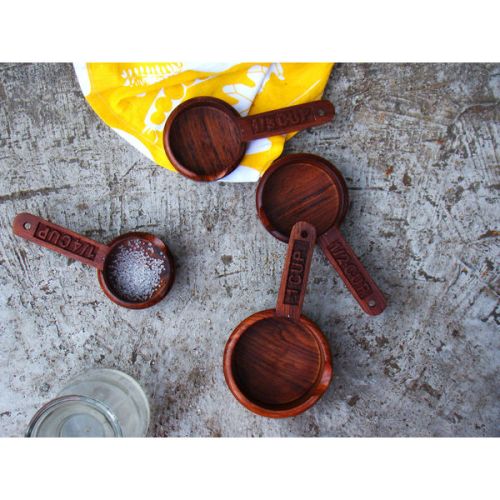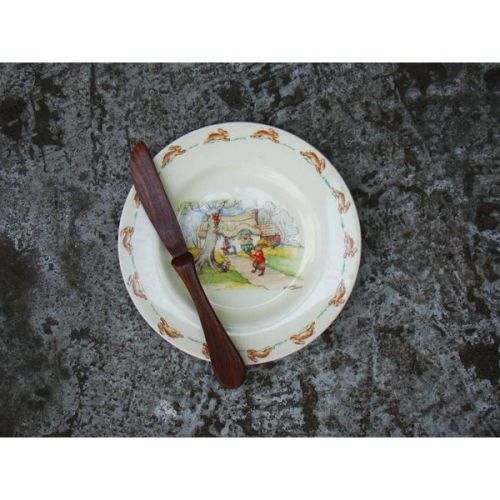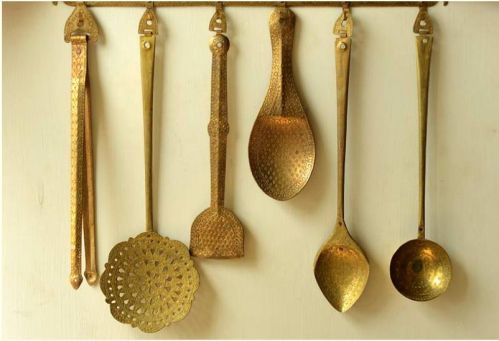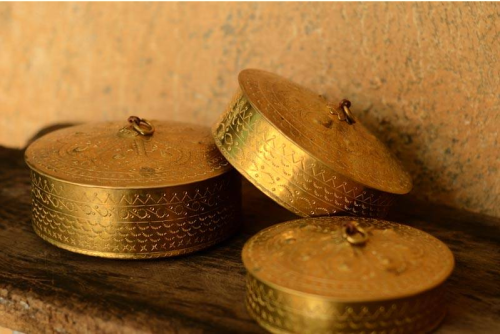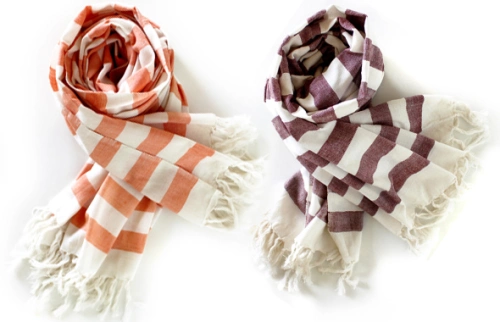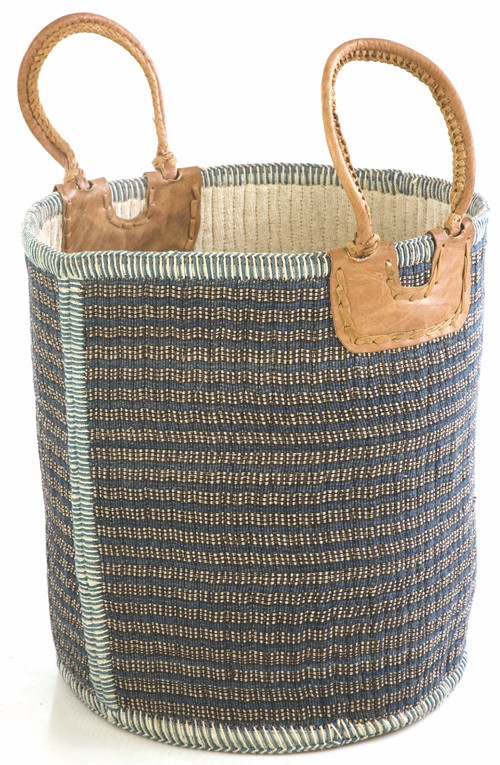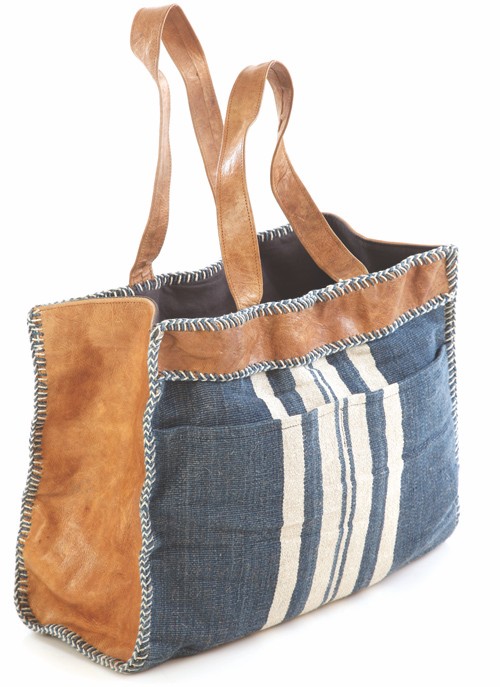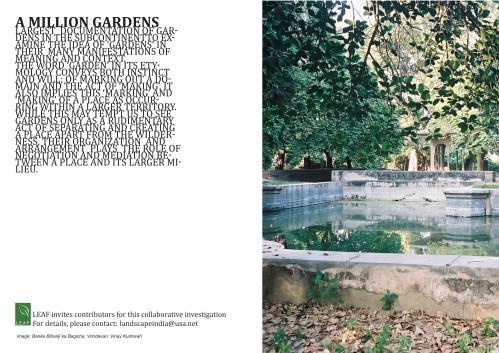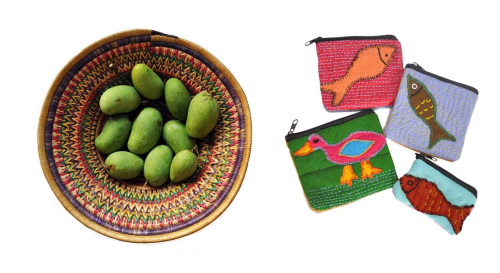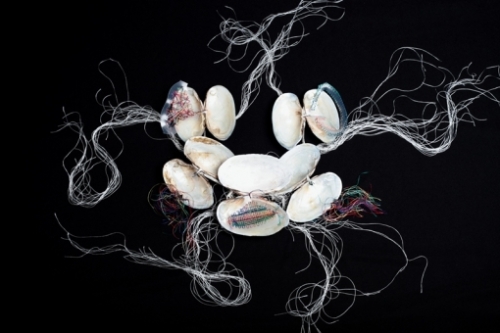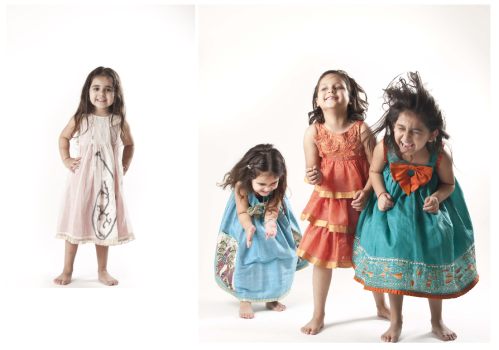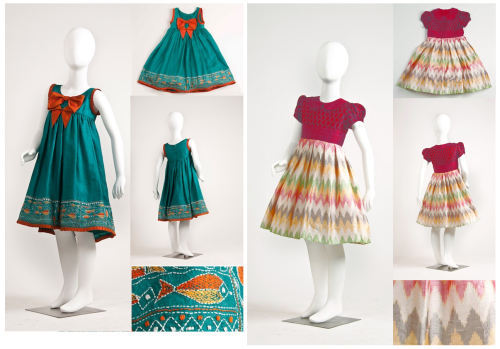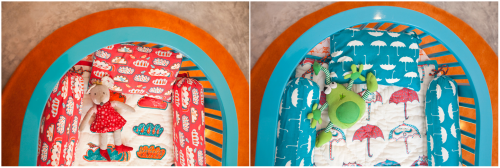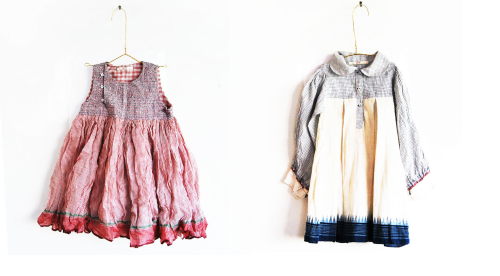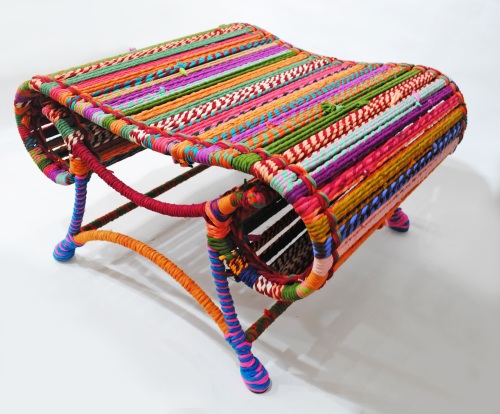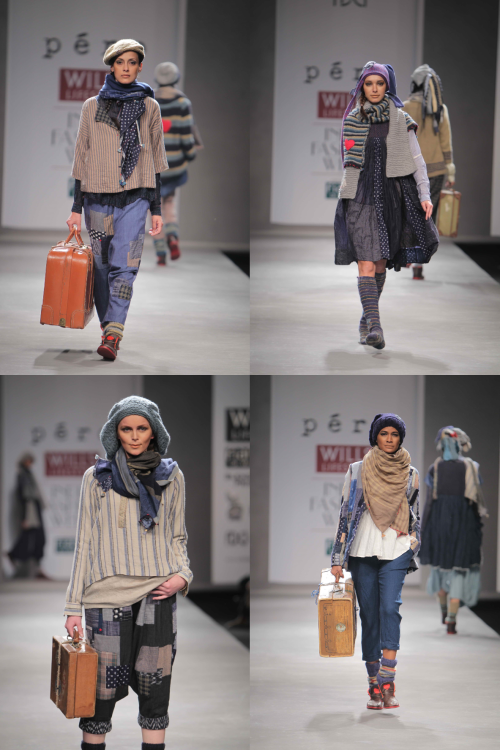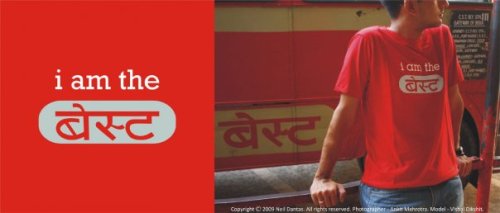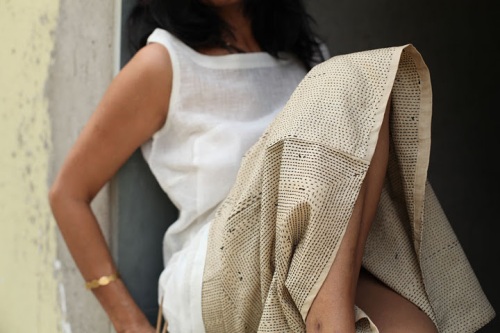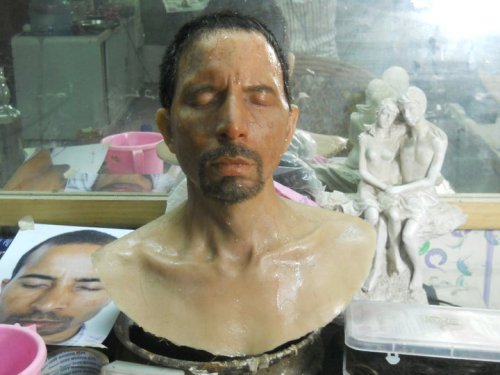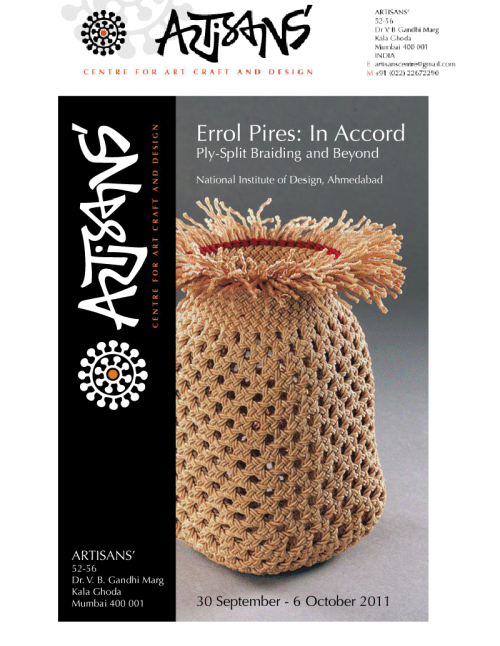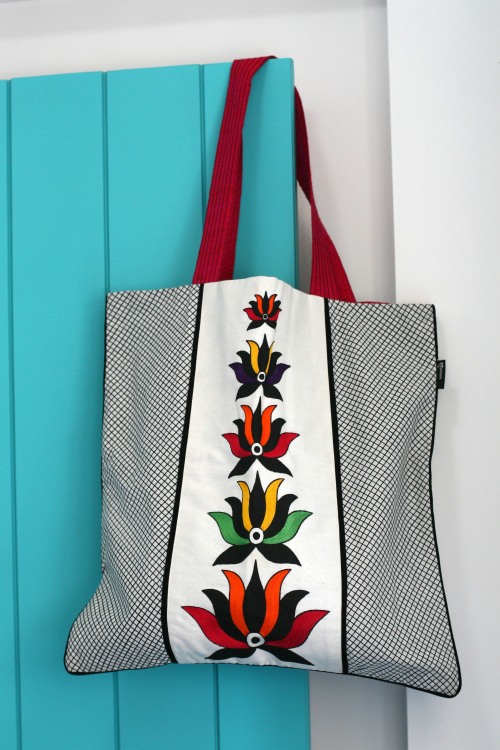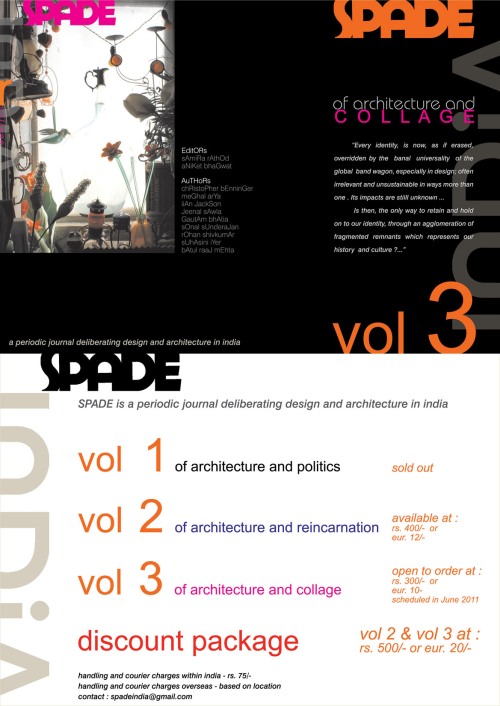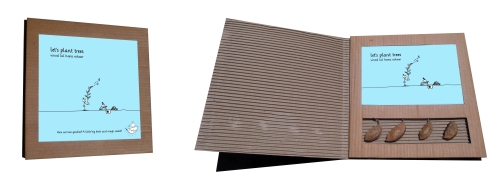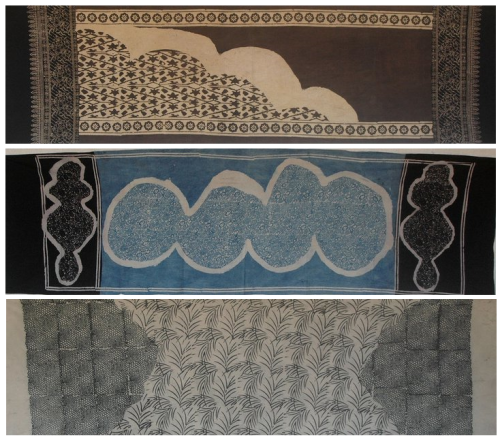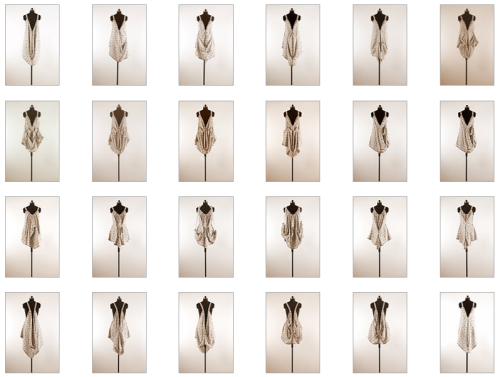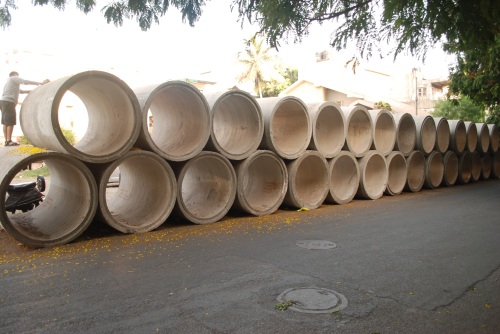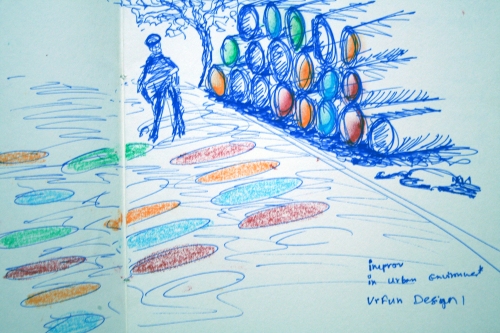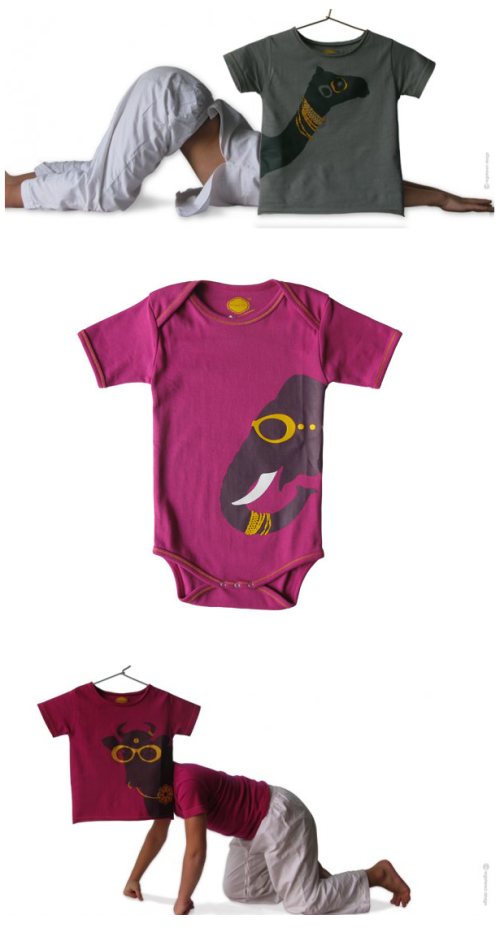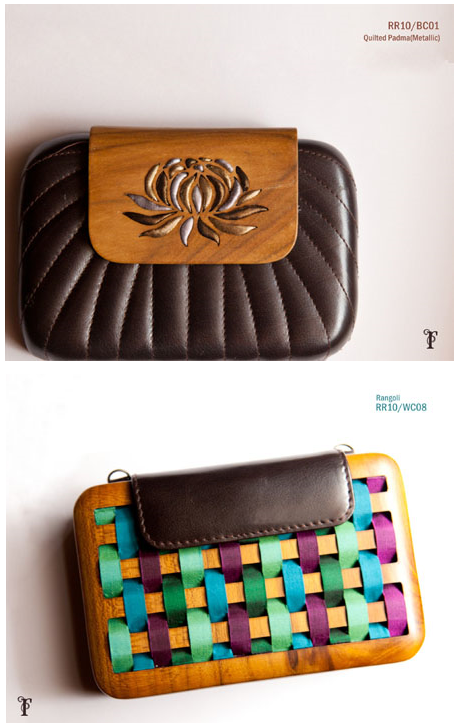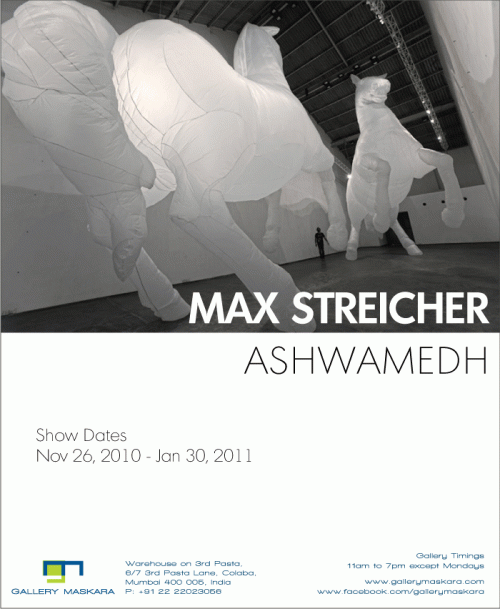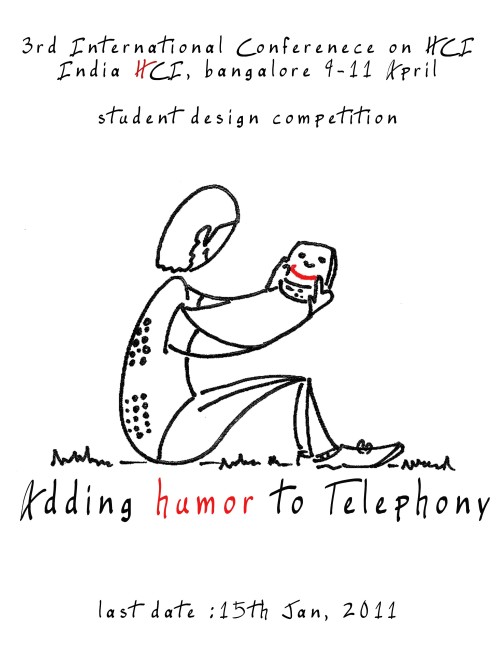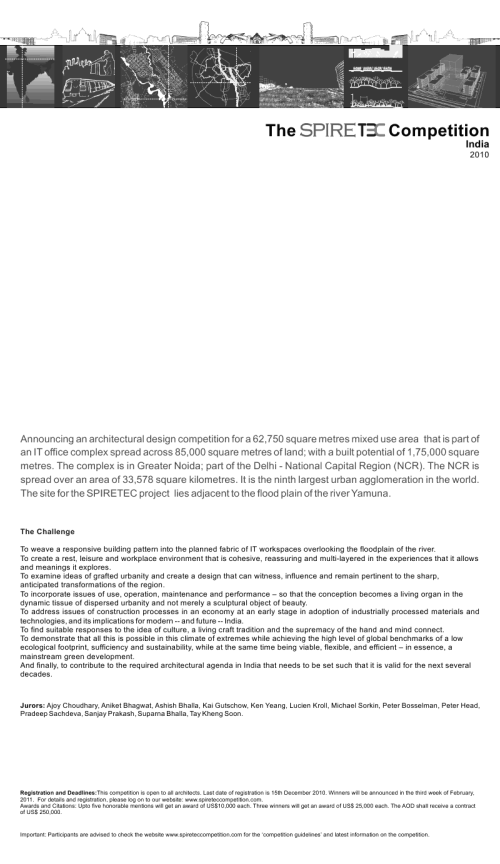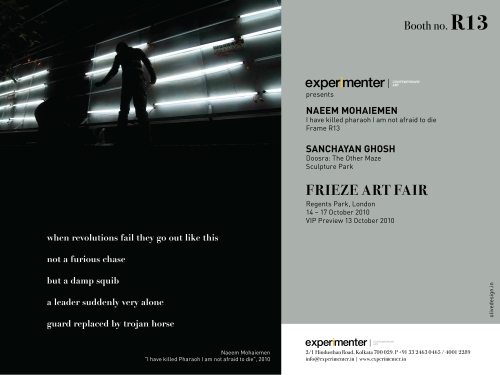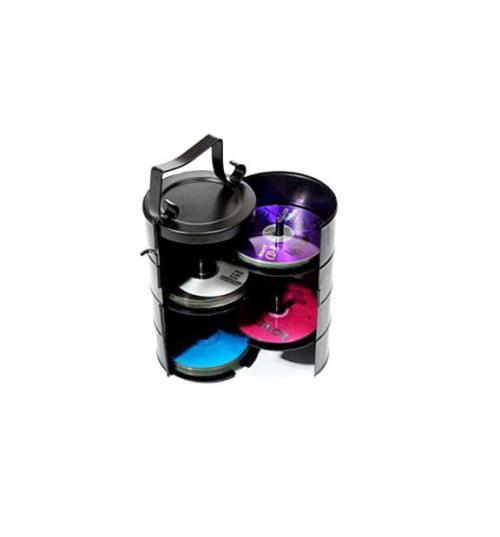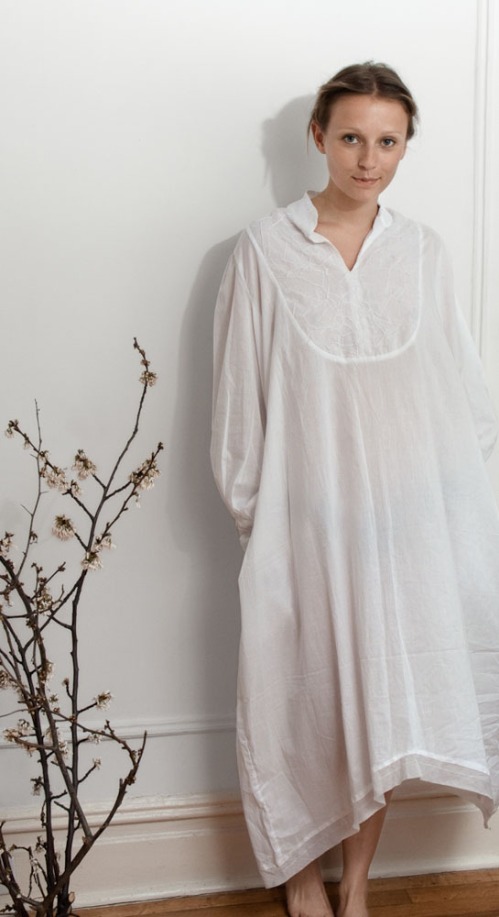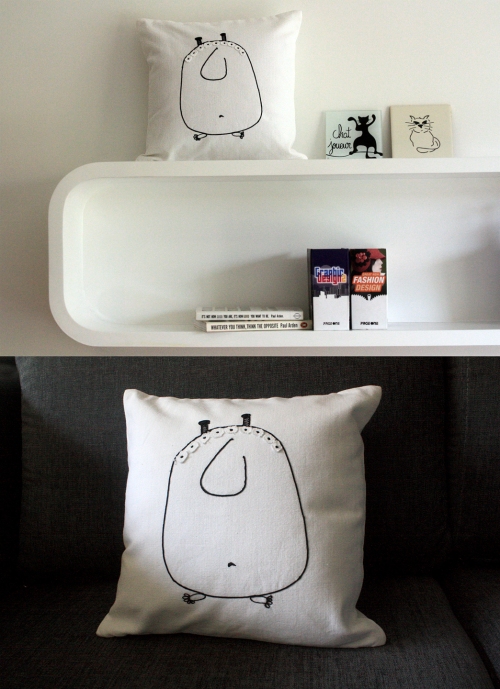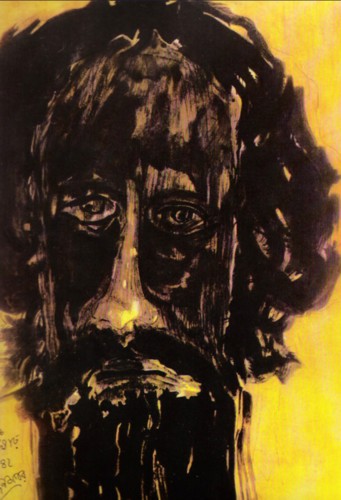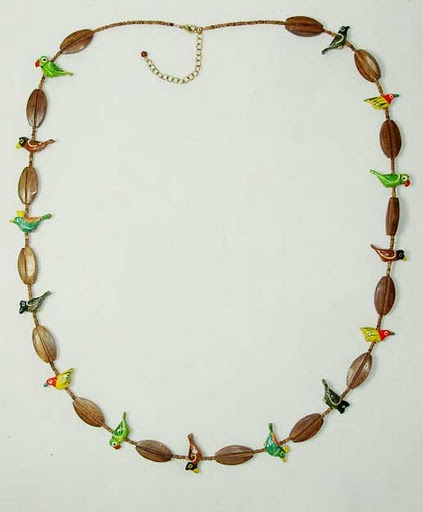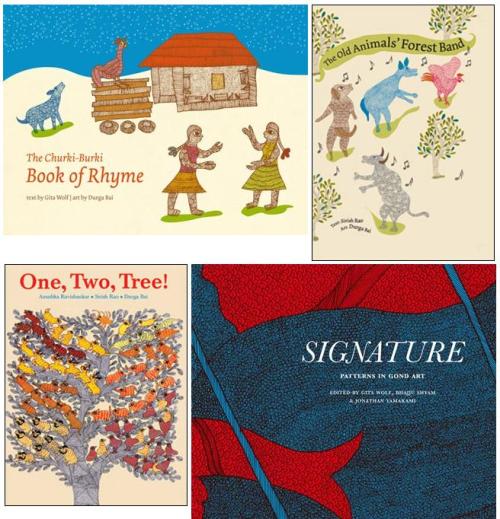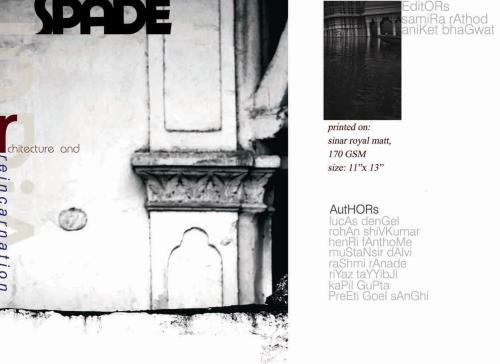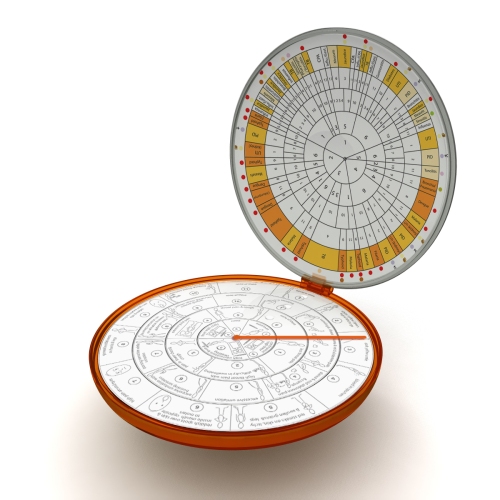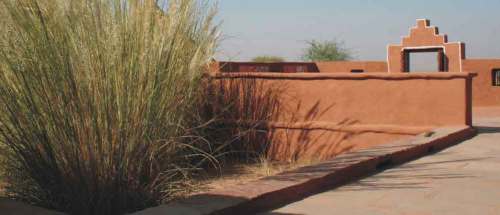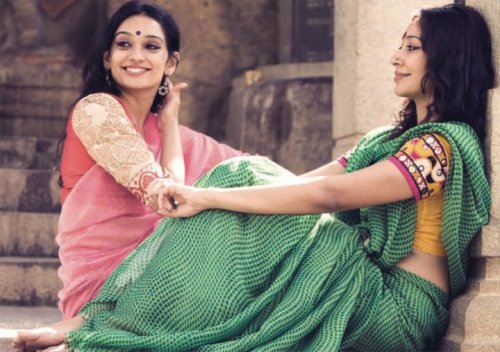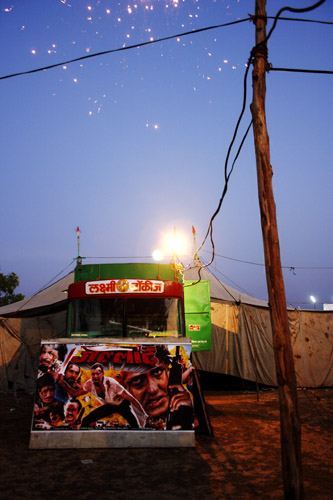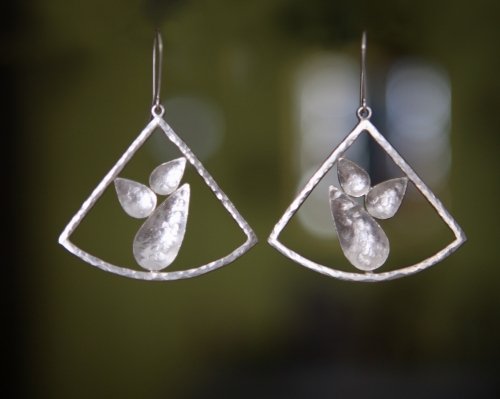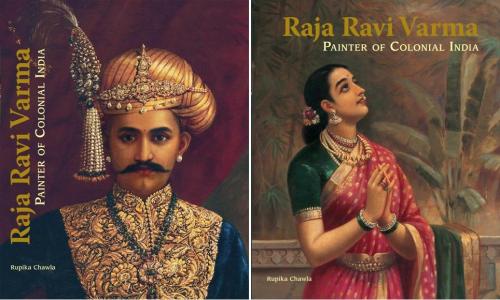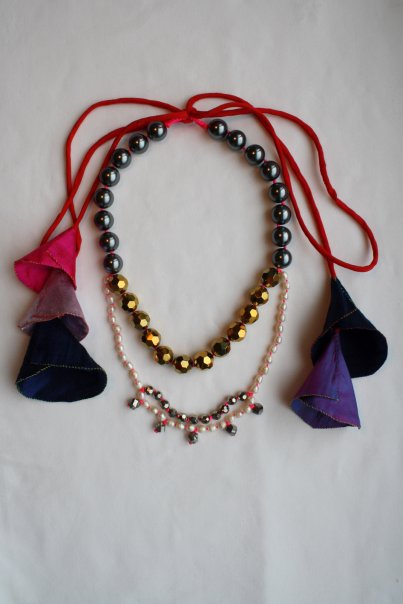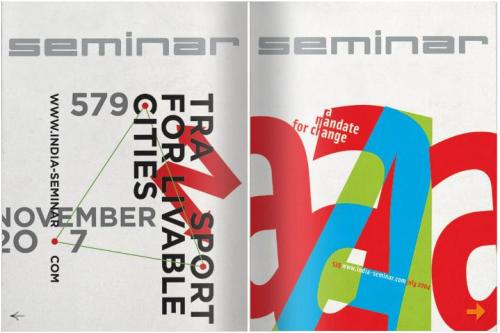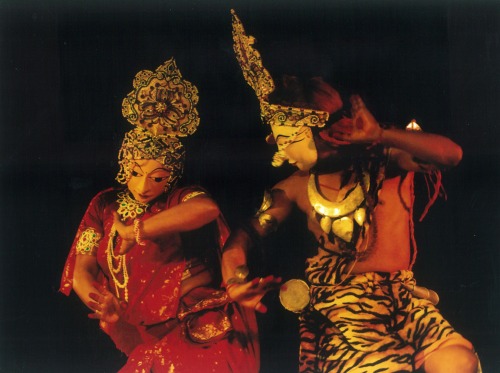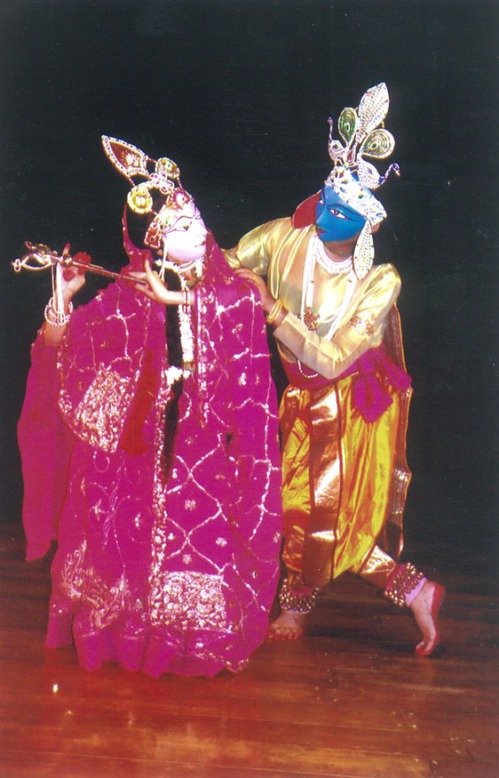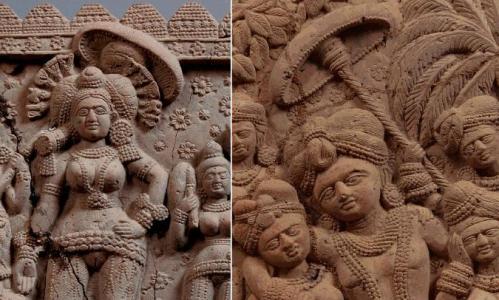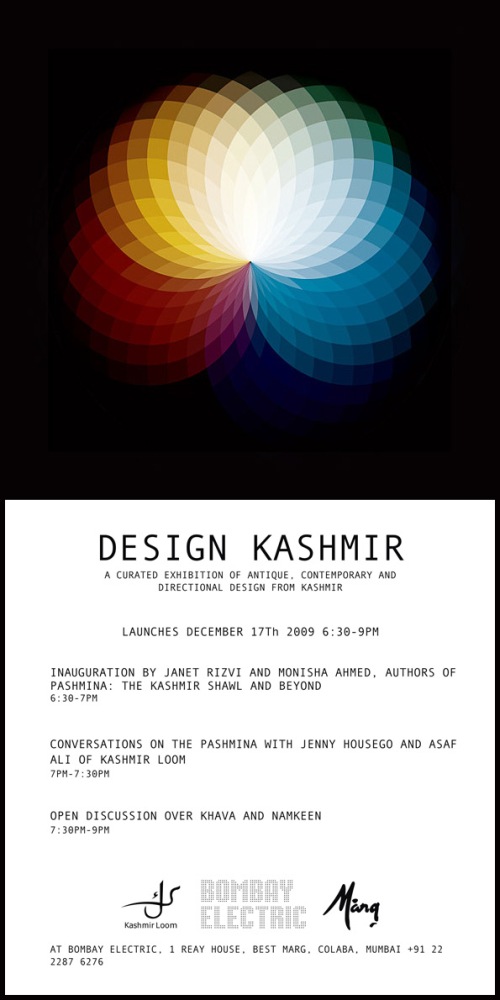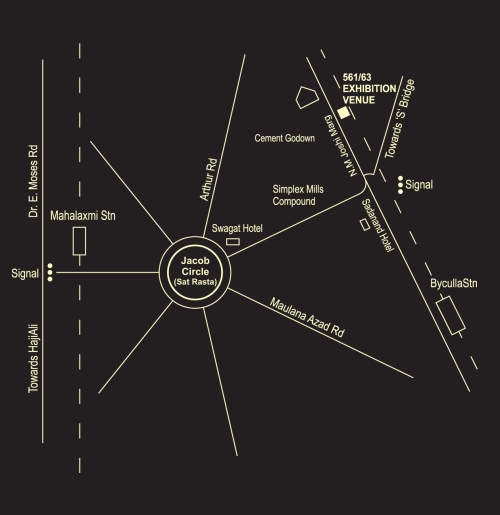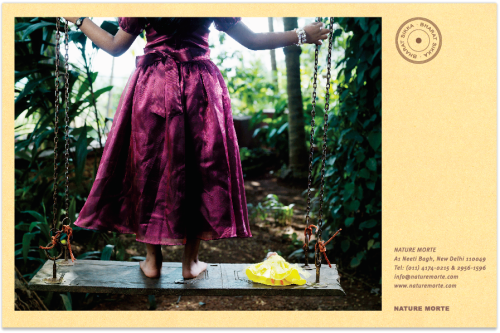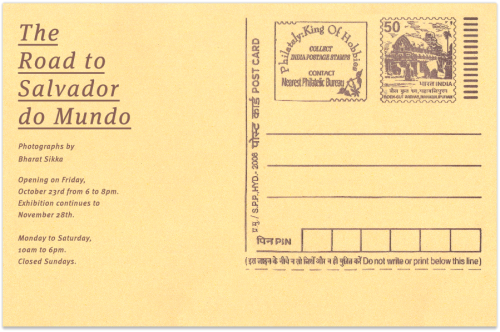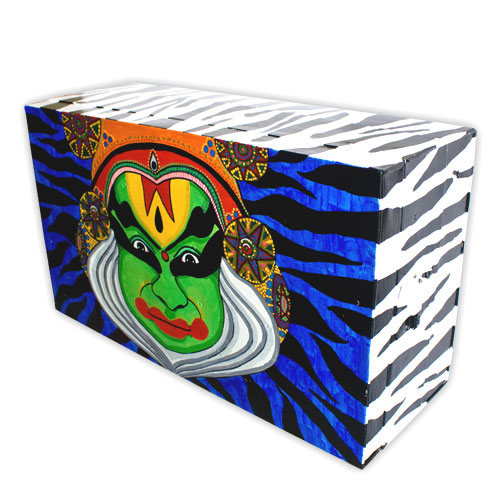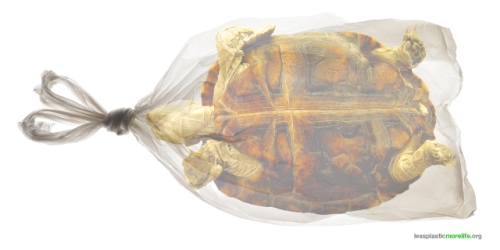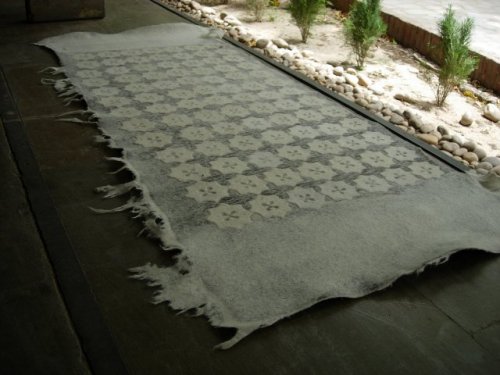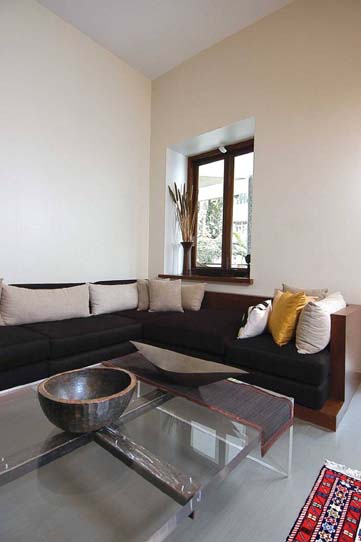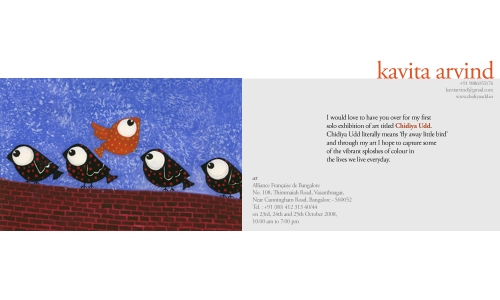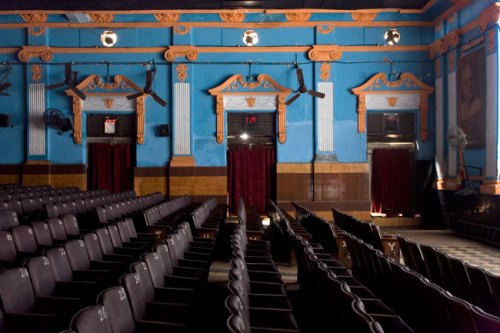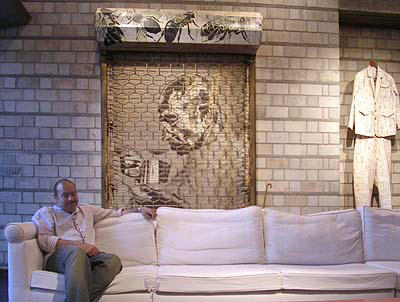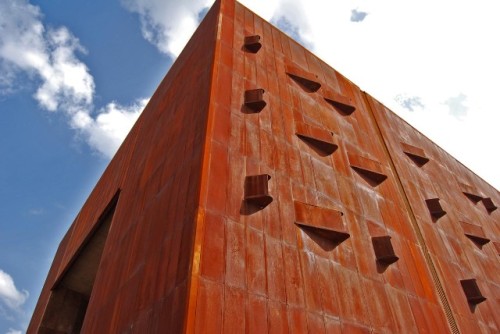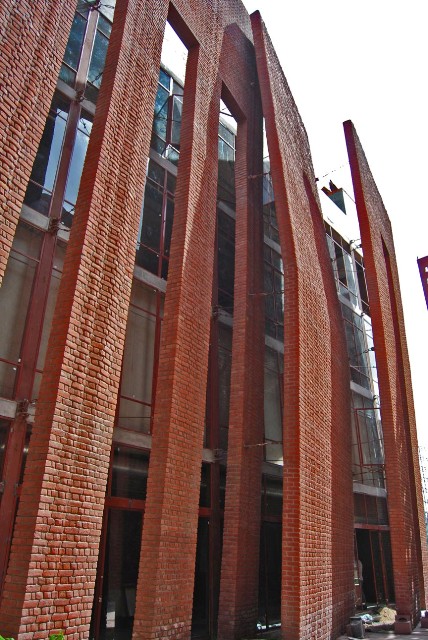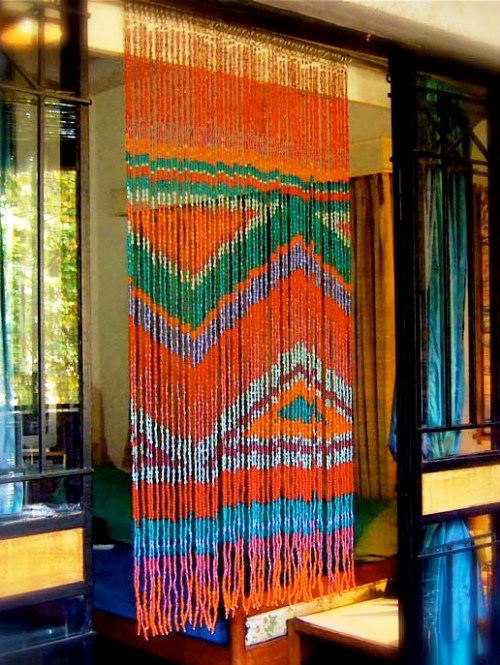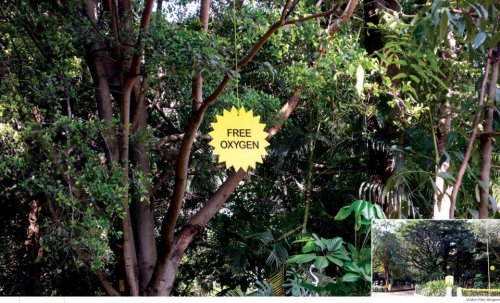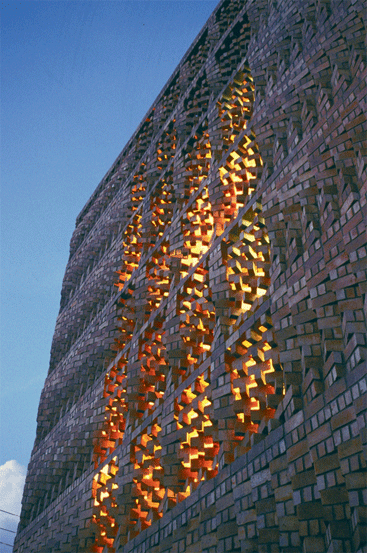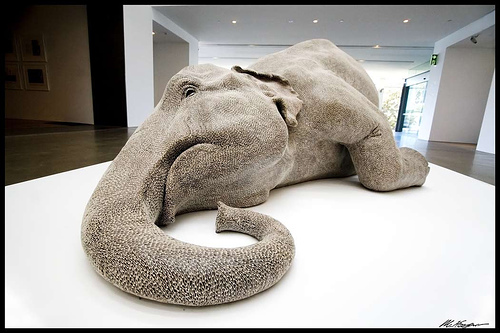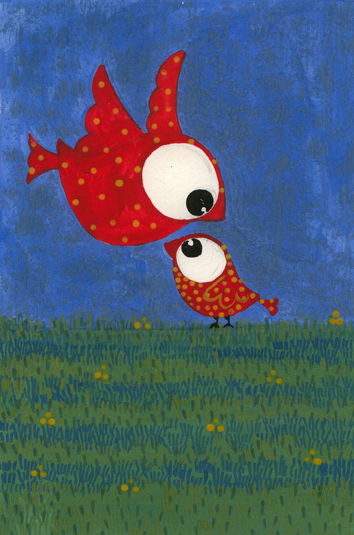Guest Post > for Krya
Preethi Sukumaran, founder of one of my favourite brands – Krya, asked if I would write a guest post for her blog on why I love handloom fabric. Preethi, thank you for the opportunity to share my thoughts. And for all your generous words. Hug. Click here for the post.
Filed under: Uncategorized | 41 Comments
Blog Glitch > Apologies
If you had signed in to receive Indian By Design posts as they are published, you probably just received a whole lot of updates for posts that were unfinished. I was changing a few settings and some of my older draft posts published as a result. They have been returned to the draft folder and will not be visible on the actual blog now. I apologise for the inconvenience and confusion. Thank you. Hug.
Filed under: Uncategorized | 5 Comments
In our daily lives, what objects do we reach out to and why – the ease of use vs the ease of care, perceived value of longevity vs the beauty of wear and tear, a juggling of price vs cost, things we save in a closet vs things we make part of our lives, Cotton vs Polyester, plastic vs wood – will it last long, will it stain, will it be worth it? These decisions often affect our buying decisions and ultimately what we surround ourselves with in our messy everyday tasks. There is much beauty in not saving the lovely things for a special day. Presenting a selection of products to enjoy using without holding them as being too precious to be a daily habit.
The Summer House – A collection of simple objects that one could effortlessly enjoy using. They seem created to be of use, to enhance the beauty of doing everyday things, to be a delight in the kitchen. The website states “The wood for our house wares is sourced from sustained plantations. 90% of our products are crafted by village folk.”
Gaatha Shop – Everything that we do becomes tradition. So in that sense, it isn’t a fixed entity, rather an evolving one. And while, to grow and progress, we must continue to adapt and create new traditions, documenting what has been is a essential step in understanding the essence of that progress. The Gaatha project has been documenting Indian craft traditions and sharing it on the Gaatha blog creating a rich resource for all to benefit from. They’ve now gone a step further and started the Gaatha Shop which completes the story by offering those who appreciate crafts the opportunity to bring them into their daily lives.
Kara Weaves – Continuing on from the thoughts expressed above, the balance between saving traditional crafts yet bringing in new design influences to keep the work contemporary has always seemed a tricky balance to achieve. These towels seem reminiscent of Turkish hamaam towels and for me, although lovely to look at, do not externally evoke the familiar Kerala Torth I grew up using. Though internally, much like the Torth, each one is handmade on traditional wooden looms in Kerala, thereby supporting local craftspeople. Founded in 2008 by social anthropologist Indu Menon and graphic designer Chitra Gopalakrishna, Kara Weaves partners with local weaving co-operatives to design contemporary home textiles. A few pieces are available to buy in India, here. Hope to see a full-fledged website that caters to Indian buyers too. These towels and the traditional Torth are a far more effective everyday alternative for the Indian summer than the bulky western options.
Shramik Kala – “Shramik Kala is a collective of 400 Craftswomen from Rajankatti, Makelmardi, Kadoli, Hunnur, Telaganatti, Madanbhavi, and Chikoppa which are drought prone regions in the state of Karnataka. This collective was formed by Shramik Abhivrudhi Sangh, a local NGO which has promoted many craft-based, sustainable livelihood projects for women who had previously depended upon seasonal wage labor and migration to cities for work. Shramik Kala has nurtured the women to revive and master many of Northern Karnataka’s craft-traditions and techniques such as: indigo dyeing of the Neelgars, rope-twisting, folk-stitching and joinery of the Nadafs, vegetable tanning/dyeing of hides and leather-crafting of the Dhor and Samgar communities, wool-felting, spinning and kambal weaving techniques of sheepherding communities.The craftswomen now earn a livelihood by making high quality, naturally-dyed, hand spun, hand woven and non-woven bags from the natural fibres of jute, cotton, banana, mestha fibre, leather, and blended fabrics.” Their products can be seen here.
Filed under: Indian Craft, Indian Design, Indian Product, Indian Product Design, Indian Research, Indian Stores | 3 Comments
Fashion Feature > Anavila
The Sari, six or nine yards of fabric that drapes women of any size, shape, height or region, can be worn in different ways – for work, play or to celebrate. Though still extremely popular for occasional wear, the everyday aspect of the sari where one lounges in it as one would in a pair of jeans today, is perhaps fading in urban India. And it is that which draws me to the handwoven Linen Saris by Anavila Mishra (NIFT) as she wills us to spend our days in them. Her decision to not embellish or add details that were not of the material seems to enhance the saris even more. The patterns are subtle and the use of colours is gentle. A sense of easy flow prevails.
Anavila also experiments with botanical inspired applique work – she loves nature, wild flowers, twigs, fruits, leaves and trees – and brings all that she sees into her work. The fabric used to create the botanical applique work is dyed and gives the work a sense of shadow and light, of different shades in the same form. It was a delight to see them. Sharing what she does.
Filed under: Indian Craft, Indian Fashion | 10 Comments
Tags: Anavila Mishra, Botanical Applique, Handwoven linen saris, NIFT
Luis Barragan once said, “a perfect garden – no matter what its size – should enclose nothing less than the entire universe.” Gardens and Landscapes create opportunities to poetically connect with the world, regardless of their size or location. Many of us might have either seen or experienced such spaces – this study invites you to help catalogue them to discover a new universe right where we are.
LEAF invites contributors for a collaborative investigation. These are their requirements.
“We are looking to document gardens and landscapes that:
1. Are stunning examples of external place making. This implies that there is a deliberate, human intervention and not a place that has evolved ‘naturally’ over time.
2. These places have to have a very strong spatial character formed and/or communicated by landscape definition and not that of the built. The built could of course be the preliminary marking of space.
3. Cultural landscapes that are of great value with a living human interface and/or a
narrative that includes, history, myth, folklore, animals, birds etc.
4. Landscape systems which might not be dramatic as immediate discernible space but will be valuable to understand as a structuring mechanism of sorts.
5. Are new narratives – agriculture, trade – new rituals and narratives for new spaces.
6. Seem quirky and unconventional; but may be of immense value to understand specific conditions or practices.
For this study, we are emphatically looking at places that are inhabited by living practices. While not discounting the value of landscapes of monuments like that of the Taj Mahal, Mandu, Sarkhej etc; the depth and range of study required to incisively look at them may not be possible as a part of this study. If, within these places there are rituals that continue today from time immemorial; we will definitely investigate them further.
Inviting all of you to participate in this investigation over the next six months. We will be collating all the data and analysis as a document at the end of the process and will share our findings with all the participants. We anticipate this to be an unprecedented collection of living gardens and landscapes of the subcontinent put together in a comprehensive manner.”
For enquiries please contact landscapeindia@usa.net
This document will be published under the auspices of ‘LEAF’; the research arm of M/s. Prabhakar B. Bhagwat. For the past four years now, ‘LEAF’ has been engaged in primary research by engaging and encouraging students through a twelve week research internship.
Filed under: Indian Architecture, Indian Research | Closed
Tags: A Million Gardens, Gardens India, LEAF, Prabhakar Bhagwat
Spotted > We Make Love
Manou, from the wonderful Wearabout, just shared this site – We Make Love. Found some lovely products in it that would work well for Diwali.
First up are fabric crackers. Perfect for those who enjoy the design but not the sound. Find it here.
Filed under: Indian Design, Indian Stores | 12 Comments
Tags: Diwali Gifts, Fabric Crackers, Manou, We Make Love, Wearabout, Winged Tealight
PUNARNAWA CRAFTS is committed to Odisha Crafts. Loved the simple details and the vibrant colours. Find them here.
Continue reading ‘Caught My Eye > Punarnawa Crafts, Boho Gypsy, Playclan, 61c’
Filed under: Indian Art, Indian Craft, Indian Design, Indian Product, Indian Stores | 7 Comments
Tags: 61c, Boho Gypsy, Playclan, Punarnawa
I support > Krya
This mention was waiting for a full-fledged post, and while that’s coming up, there’s no reason why everyone can’t enjoy this product till then. Launched in September 2011 by Preethi Sukumaran and Srinivas Krishnaswamy, Krya is a natural and sustainable detergent that works with your hands as well as with your washing machine and of course the environment.
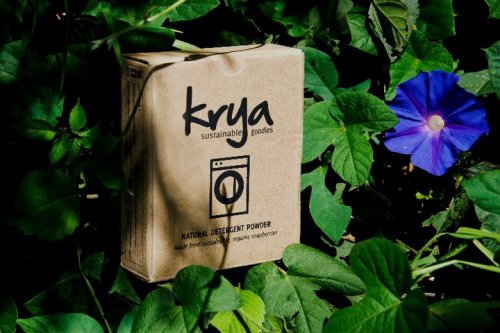
>> Get your pack here, read their informative blog, follow them on facebook. Picture courtesy Krya.
Filed under: Indian Product, Indian Stores | 1 Comment
Tags: Indian Product, Krya, Preethi Sukumaran, Srinivas Krishnaswamy, Sustainable Detergent Powder
Fashion Feature > Swati Kalsi
While preserving existing traditions of craft is vital, it’s equally important to foster new ways of seeing. I first saw work by Swati Kalsi (NIFT Delhi 2002) at an exhibition by Jiyo! at Southbank, London. I spent a considerable amount of time following the myriad embroidered patterns. It was evocative even though it wasn’t a familiar grammar of objects and figures that we enjoy seeing in a lot of embroidery from India. There was an order in the seeming randomness – it brought to mind images of terrain mapping and cartography. The garments the embroidery forms part of enhance the work – they seem roomy, comfortable and the embroidery follows the silhouette in a fluid manner – as if in movement itself. Here are a few images from her work. I hope you enjoy it as much as I have.
Filed under: Indian Craft, Indian Fashion | 5 Comments
Tags: Indian Embroidery, Indian Fashion, Indian Textile, Jiyo!, Swati Kalsi
Caught my eye > The Musalman
This is a 2008 documentary by Hinterland Films on The Musalman.
The Last Calligraphers from Hinterland Films on Vimeo.
Via 100 Hands.
Global Voices says :”The earliest forms of newspaper were handwritten and now ‘The Musalman‘ probably is the last handwritten newspaper in the world. This Urdu language newspaper was established in 1927 by Chenab Syed Asmadullah Sahi and has been published daily in the Chennai city of India ever since.”
This was a more recent report on The Musalman.
Via Global Voices
Filed under: Uncategorized | 4 Comments
The Origomu site states that “Over 46,000 pieces of plastic litter are floating on every square mile of ocean today, killing 2 million sea birds and 100,000 marine animals every year, with many getting entangled in plastic six-pack rings.” To create awareness and re-use of plastic waste, Origomu invites and inspires people to make jewellery from these objects and shares the work on their site.
These are Sham Patwardhan-Joshi’s creations using six pack plastic rings, shells and thread. I loved the way it connects to the cause of saving marine life by using elements left over from settlements in the sea alongside elements left over from settlements on the Earth. Makes one think of what we contribute to the planet. The photography makes the creations look like undersea creatures and the names are evocative. Would love to see them for real.
Filed under: Indian Jewellery | 2 Comments
Tags: Origomu, Sham Patwardhan-Joshi, Six Pack Plastic Rings
Caught My Eye > Litttle Prachee, Sotomoto, Gnaana Multi-lingual Alphabet Blocks, Pero for children
Some refreshing products for children that I enjoyed seeing.
Litttle Prachee
Prachi Walia (NIFT) grew up travelling across India, discovering Indian textiles and now brings it all into her collection. Vintage ‘mom-crafted’ frocks, and the joy of dressing up inspired her in creating Litttle Prachee. Love the use of embroidery, Indian fabrics and the sense of play – would love to see some for boys. You can find more of her work here.
Sotomoto
The prints are playful, the colours are happy and many are gender neutral which is wonderful. Sotomoto is at 24/2 Hauz Khas Village on the ground and 1stfloor, Tuesday to Sunday from 11am to 7pm. And online here and here.
Gnaana – Multi-linguaal alphabet blocks
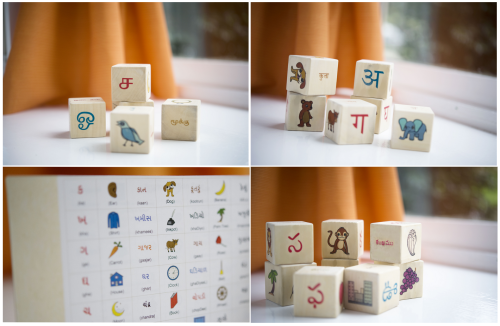
The Gnaana alphabet blocks are truly practical and meaningful. And a wonderful way to introduce your child to a new language. You can pick yours here.
Pero, for children
Aneeth Arora’s Pero is a delightful brand. It tucks in lots of lovely details and brings together varied Indian fabrics like ikats, natural dyed khadi, woven chanderis, gamocha from Assam, telia rumals from Andhra Pradesh. Get some here.
Filed under: Indian Craft, Indian Fashion, Indian Product Design | 4 Comments
Tags: Children, Gnaana, Litttle Prachee, Multi Lingual Alphabet Blocks, Pero, Sotomoto
Design Feature > Katran
Materials are given second lives in India everyday. Newspapers into peanut cones, old saris into quilts, jeans into storage bags, vegetable peels into compost. Sahil Bagga (College of Art, 2002, Politecnico di Milano) and Sarthak Sengupta (NIFT 2001, Politecnico di Milano) researched on farmers spinning left-over fabric strips (Katran in Hindi) from cloth mills into ropes for making Khatias (string beds). They developed the idea as part of their ‘Zero Kilometre Design Concept™’ to later create a collection of products named Katran.
Sarthak Sahil Design Co was founded in 2009. A multi-disciplinary practice, it works on furniture, products, graphics, brand consultancy, trend development and research, interiors and spatial design. Their portfolio has a mix of identities – the interiors seem to dwell on symbolism, the lamps are slightly kitsch and objects like the metal platter and jewellery have a different aesthetic altogether. But on the whole, the effort seems to do something that is grounded, crafted, local and Indian. Their collection, Katran, seems a coming together of thoughts towards that direction.
Filed under: Uncategorized | 11 Comments
British Council Arts did series of interviews with those within the design sector on what the design industry in India is all about and where is it headed. I found Laila Tyabji’s thoughts especially enlightening.
Design Industry in India by Laila Tyabji from British Council Arts on Vimeo.
More interviews here.
Filed under: Uncategorized | 2 Comments
This one made me laugh out loud. Time indeed is a flexible commodity for many of us in India. There is an unsaid rule of sorts, a subtext that once understood adds clarity to interactions. This watch makes it explicit.
Filed under: Indian Product Design | 14 Comments
Tags: Alok Nanda, Hyphen Brands, Indian Product Design, Indian Stretchable Time, Prassana Sankhe
Discovered! Kuhelee Khandelwal
I discovered her three years ago and it’s taken this long to convince her to share her work. Kuhelee has a delightful mind. And an intimate way of crafting things. A stray bead, left over wire, pins, scrap fabric – she sees possibilities in everything around her. And has the ability to make it look aesthetic. We are family now, so I have even more opportunities to see her work up close. Sharing her creations and her thoughts.
Pentee-pies (as named by her equally creative daughter Tara)
Filed under: Indian Art, Indian Craft, Indian Design | 16 Comments
Tags: Clay Creatures, Elephants Remember, Kuhelee Khandelwa, Kuhelee Khandelwal, Memory Box, Paper Weights, Pebble Drawings, Pentee Pies, Stone drawings
Photography has changed the way we look at the world. How photogenic a thing is has gained much importance. Something that makes it difficult for details, subtlety and intricate work to stand out at times. Especially so when the context is a fashion show. Movement, distance, lights, everything affects what we see. And it’s unfortunate because details is where a lot of the magic really is. The team at FDCI shared a few images from the WIFW. In no particular order, here’s a pick of what caught my eye with some details picked out so one can look closer.
Continue reading ‘Caught my Eye > Wills India Fashion Week AW12 – Part One’
Filed under: Indian Fashion | 3 Comments
Tags: Aakaro, Anand Bhushan, Anand Kabra, Aneeth Arora, Anju Modi, Anupama Dayal, Autumn Winter 2012, AW 12, Bhanuni, Caravan, Dev R Nil, FDCI, Gaurav Jai Gupta, James Ferriera, Junkyard, Jyoti Sharma, Kami, Khwaja, Pero, Rahul Mishra, Surat n Spice, Vaishali S, Vineet Bahl, Wills India Fashion Week
Design Feature > Neil Dantas
In an increasingly cosmopolitan city with an expanding population and widening city limits, how does one capture a sense of identity that has meaning for all?
Exploring such thoughts, I share the work of Neil Dantas (JJ School of Arts, NID). A designer with talent and good intentions who seems to live close to the ground. I enjoyed his work on Mumbai which is a first hand experience of the city. As an old resident, I identify with his graphics and words, said and unsaid.
Filed under: Indian Design | 12 Comments
Tags: Indian Design, Mumbai T-shirt, Mumbai Tee, Neil Dantas
Bhagyanath C – Ventriloquism
Kashi Art Gallery Archives, December 12, 2010 – January 7, 2011
The series delves into the theory of Evolution and the awareness of the shared fate of the beings of the world. This interaction between Pig and Man seemed so peaceful and complete – no foreignness in their touch, only familiarity one would show someone they are connected with or deeply understand. Poetic.
Continue reading ‘Caught My Eye > Bhagyanath C, T.S. Satyan, NN Rimzon, Priti Vadakkath’
Filed under: Indian Art, Indian Photography | Closed
Tags: Bhagyanath C, NN Rimzon, Priti Vadakkath, T.S. Satyan
Shout Out > Poonchh by Aarohi
Aarohi Singh is putting her art where her heart has always been. Poonchh is a collection of products created in aid of stray dogs. It will be showcased at 100Ft restaurant, Indiranagar, Bangalore on the 10, 11 and 12 February 2012. A great way for those who feel for the cause to show their support by bringing home products that would create a more humane future for stray dogs.
Filed under: Indian Design, Indian Graphic Design | 11 Comments
Tags: Aarohi Singh, Poonchh, Stray Dogs, VoSD
Caught my eye > Chai Paani, Naqqashi Platter, Kaagazi, Junk Mirror, Recycled Paper Jewellery
Chai Paani money bank. Fitting considering the political climate.
Available at Store ABD, Whitefield – Banaglore, U store, Delhi and Mumbai and online at Shopo
Continue reading ‘Caught my eye > Chai Paani, Naqqashi Platter, Kaagazi, Junk Mirror, Recycled Paper Jewellery’
Filed under: Indian Craft, Indian Product Design, Indian Stores | 2 Comments
Tags: Chai Paani, Dhokra Platter, Junkyard Mirror, Kaagazi paper bags, Recycled paper jewellery
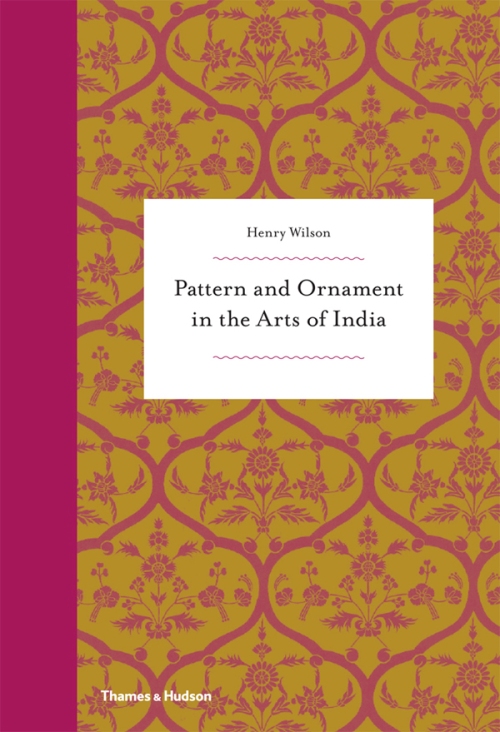
As visitors to grand Palaces, Temples, Mosques and Tombs, we are likely to come away more with awe than with a picture of what we have really seen. Often, details merge with a memory of the whole. Until someone points out the complexities and captures them so we can study how the place came to be. Henry Wilson’s Pattern and Ornament in the Arts of India is a book about such details. The ones we might miss in a rush to photograph the entirety or struggle to recall in the midst of colour, light, sound and movement. The introduction sets the real premise of the book. The author-photographer shares pictures of patterns and prints from all over India – henna, truck art, block printing, textiles, floor tiles – and clearly states that this book will not be covering any of them. This is a book on Pattern and Ornament as seen in the Architecture of North-West India. And to that end, the book is faithful to its subject.
Continue reading ‘Book Review > Pattern and Ornament in the Arts of India’
Filed under: Indian Architecture, Indian Art, Indian Craft | 3 Comments
Tags: Book Review, Henry Wilson, Pattern and Ornament in the Arts of India, Thames and Hudson
Aarti Verma of Art Meets Fashion. Hand-painted by Aarti, bags made by Karigars. I liked these three from her hand-painted work. More of it here – Blog and facebook.
Continue reading ‘Caught My Eye > Aarti Verma, SAS Home, Maati, Raja Gondkar’
Filed under: Indian Craft, Indian Fashion, Indian Product Design | 3 Comments
Tags: Aarti Verma, Ajrakh, Art Meets Fashion, Bahi Khaata, Conference Kit, Hand Painted Bags, Heaven and Home, Leather folder, Maati, Papier Mache Jewellery, Raja Gondkar, SAS Home
Fashion Feature> SLOW. useless.
Today, our fingers and hands do more of this – typing words onto screens, hailing taxis, raising toasts, holding files, carrying shopping bags – and less of this – folding paper to make planes, digging through mud to sow a seed, sewing a button, threading a needle to darn a tear. The process of making is ebbing from urban lives and with it, perhaps a sense of what our hands are capable of creating.
Padmaja Krishnan (NIFT Delhi) opens her installation and sale of hand-crafted clothes at the Artisan Gallery today. In form, her clothes are contemporary; in content, they bring together skills and traditions from the past. She terms them slow and useless. Slow because the pieces are hand-sewn, cared for and given time to take form. Useless since she revives rags and castaways and houses them in new ways.
Wearing something handmade and knowing what went into the process makes that particular piece of clothing radiate with character. It is then difficult to not feel cherished while wearing it. Padmaja’s decision to take time making what she makes is bound to affect the character of her garment and that in turn is bound to affect the wearer. Perhaps a sense of slow will permeate and the wearer will stop to appreciate the seams and threads and colours and then perhaps it might become a reason to be aware of everything around them. All because someone choose to take time and go slow.
Spend some time in her slow and useless world and if you choose, bring it back into yours.
Filed under: Indian Fashion | 6 Comments
Tags: Hand Crafted Fashion, Indian Fashion, Padmaja Krishnan, Slow and Useless
Dirty Hands
Rajiv Subba (Chandigarh Art College, NID) and Mamta Gautam (SPA, NID) got together to experiment and delve into something that had no set precedents in India. They formed Dirty Hands, a company that now makes hyper-realistic silicon mannequins and prosthetics for films and works at recreating what we experience.
Though trained in art, architecture, ceramic and glass design, their skills as mannequin makers is self-taught. Which is probably why their office is a cheerful collective of talented friends from various fields with no ‘degrees’ in hyper-realistic work. Their work is convincing and brings out the Indian skin tone and character impressively. Dirty Hands, though pioneering in India, still has some way to go if compared to hyper-realistic works around the world. But it does open up possibilities to create new experiences in the country by people who have an affinity to the stories within.
Mark Twain once said, ‘Fiction is obliged to stick to possibilities. Truth isn’t’. Creating a realistic portrayal of something that once was or still is means there is material to adhere to, possibilities unexplored because a finite object has finite rules that bind it. The idea of portraying reality, to me, seems more in the realm of fantasy, to create something that really isn’t. A clone of reality, distinct in its fictional self and boxed in finite possibilities. Thus not real. No matter how alike.
Let’s interact with the fiction of reality, painstakingly created by Dirty Hands.
Filed under: Indian Product Design | 19 Comments
Tags: Dirty Hands, Silicon mannequins
Exhibition Schedule
Launch event, Thursday, September 29, 2011 (By invitation only):
Woven Woolen Strands of the Desert, a lecture by Jasleen Dhamija, an authority on Asian textiles
Ashoke Chatterjee, former Exceutive Director, NID and former President, Crafts Council of India
Opening times: 7 days a week, 11 – 7 pm
Filed under: Indian Craft | 7 Comments
Tags: Artisans, Errol Pires, Indian Exhibition
Nidhi Dube from the Indian Institute of Craft and Design wrote to me to introduce Tejas Soni and his experiments with the Dhokra craft. Dhokra is an ancient craft practised by nomadic tribes who have since settled into parts of West Bengal, Jharkhand, Orissa and parts of southern India. One of the earliest known pieces found was the Bronze dancing girl at Mohenjadaro. The craft is practised by both men and women and the objects are cast in metal using what is known as the lost wax process. Today it features more as a exotic buy rather than a relevant ingredient in our daily lives as it was in the ancient times when religious figures, jewellery, diyas, animal figurines and vessels were essential in many homes.
The revival, support, reinterpretation of any ancient art is often met with skepticism – will reinterpretation dilute the legacy or turn it into something commercial and ubiquitous and most important of all, will it benefit the ones who started it all. Tejas Soni works with artisans to reinterpret Dhokra in the modern context – the work is clean and the objects are utilitarian thus can merge in our daily life easily. The forms within it make me wonder – a platter with a cowherd and his cows, a jug with a tribal man on the handle, tribal girls in a trivet – the forms used by the metalworkers in ancient times were an interpretation of the times they lived in – for us, these forms, though lovely, are far removed – how will we choose to interact with them – will we be conscious of their presence or will they perhaps be, just another design element. Let’s explore his work and views.
Continue reading ‘Product Design > Experiments with Dhokra by Tejas Soni’
Filed under: Indian Product Design | 21 Comments
Tags: Dhokra, Dhokra Art, IICD, Tejas Soni
Bloggers Against Plagiarism
To copy is to kill one’s own source of creativity. True inspiration is about admiration, respect and progress. About interpreting what you like, to create something altogether new and often unrecognisable from what inspired it. If it looks exactly like what inspired it, it is a copy or a lack of imagination. I hope all among us who seek inspiration will see the difference in the two and opt for the latter.
A new blog initiated by dedicated makers and creators, who recognise the damage that copying can cause to business and morale, especially for small businesses, now makes it possible for people to share their copyright violations and plagiarism issues. If you have faced similar issues, do get in touch with them, along with of course, pursuing all possible action that you need to.
Filed under: Uncategorized | 10 Comments
Tags: Bloggers Against Plagiarism
Design Feature > Ek Karkhana
Social networking has created opportunities for creative businesses to get in touch with their audience more intimately and immediately than ever before. It has also created a surfeit of businesses of varying quality. But many do shine through. Ek Karkhana is one such business. It caught my eye largely thanks to their non-dependence on ubiquitous kitsch and their simple, graphic aesthetic. They work from a small workshop, with a team of kaarigars, are passionate about craft and have big plans for the future. Let’s take a closer look.
Filed under: Indian Craft, Indian Product Design | 13 Comments
Tags: Bags, Craft, Ek Kharkhana
Just Published > Spade Issue 3
The third issue of Spade is here. It deals with architecture and collage and as always promises to throw up questions and thoughts. Contributors include Christopher Benninger, Batul Raj Mehta, Iian Jackson, Gautam Bhatia, Jeenal Sawla, Rohan Shivakumar, Meghal Arya, Sonal Sunderajan, Suhasini Iyer, Aniket Bhagwat and Samira Rathod. You can view a sample of the inside pages via the pdf link below. Orders can be placed via the email id provided. Those interested in research work with SPADE can email for positions at Ahmedabad and Mumbai.
A few sample pages of Spade 3 in this pDf : Spade 3
Contact spadeindia(at)gmail(dot)com
Filed under: Indian Books, Indian Design Criticism | 1 Comment
Tags: Aniket Bhagwat, architecture and collage, Batul Raj Mehta, Christopher Benninger, Gautam Bhatia, Iian Jackson, Indian Architecture, Jeenal Sawla, Meghal Arya, Rohan Shivakumar, Samira Rathod, Sonal Sunderajan, Spade Issue 3, Suhasini Iyer
Design Feature > Mitti Cool
*An Indian By Design Exclusive*
Basic living, in urban and rural areas, has expanded from food, clothing, shelter to include tv, mobile phone, laptop, washing machine, fridge, water heater, ac, car and more. All of which are dependent on fuel/electricity to make them work. The key to living in the future might just depend on how we are able to gain independence from the circle of resources – by building our own homes, growing our own food, even creating our own energy. It is perhaps a way to ensure equitable distribution, responsibly. But for now, these uber basics are vital in our lives, and we must navigate them as best we can. Until an uber cool alternative shows up at our doorstep.
Introducing the MittiCool Fridge.
I’d previously read about ChotuKool, the Godrej fridge that ran on batteries, but this was even better. Purvi Sanghvi, from The Other Side, travelled to Gujarat to take pictures and chat with Shri Mansuk Lal Raghavji Bhai Prajapati from village Wankaner in Gujarat on his invention – a clay fridge that keeps food fresh and cool, without electricity.
Filed under: Indian Product Design | 28 Comments
Tags: Clay pressure cooker, Fridge without electricity, Indian Product Design, Mitti Cool, No electricity fridge, Purvi Sanghvi, Shri Manshuk Lal Raghavji Bhai Prajapati, Wakaner
I support > Let’s Plant Trees
Vinod Lal Heera Eshwer is a nature evangelist. A nurturer much like Dickon in the book, The Secret Garden. His children’s book, Let’s Plant Trees, is filled with Vinod’s charming sketches to show the true saviours that trees are in our life. The book comes with a gift of seeds that literally helps sow a love for trees in a child.
>> A review of the interesting launch of the book can be read here. The book is published by Tulika and is available at Strand, Mother Earth and Books for Change. Let’s Plant Trees also has a blog. Vinod also promotes Trees for Free.
Filed under: Indian Books | 2 Comments
Tags: Let's Plant Trees, Seeds, Trees, Tulika Publishers, Vinod Lal Heera Eshwer
My first sighting of a tote bag was perhaps the woven plastic ones, the kinds that Madras maamis carry. When we moved to Mumbai, I saw my kaam-waali-bai carry a green printed cloth one and often wondered what she kept inside. Turned out to usually be paan, beedi and some food she gathered from her home visits. In Kolkata, I watched them call it jhola and it was the man-bag before man-bags ever became fashionable (or are they). The Tote is an essential now, easy to carry and inexpensive to collect. They’re also an easy canvas for designers to showcase creativity. And the all-important rallying cry against plastic. Which is why Jitesh Patel’s book is fun and interesting. It takes something that has become such an ubiquitous part of our world today and catalogues it. His interest clearly being in its graphic output and the designers who created them. The form is the same, the designs keep changing. In some cases, it relates to the form of the bag, in some to the use it could be put to. But largely, it’s used much like canvas, with no interaction to its purpose as a bag. The designs could just as well work as a tee, but a bag is perhaps easier to make, one size fits all.
< Photograph courtesy Jitesh Patel. Jitesh Patel is a designer and illustrator. He runs a multi-disciplinary digital design studio, Jai Studio, in Shoreditch, London. He also has a blog dedicated to tote prints. If you’d like to submit your own ‘self-initiated, self-published and commercially available project for potential inclusion in future editions of this book’, do so here. >
If you’d like to make your own Tote bags, check Morsbags for instructions.
Filed under: Indian Graphic Design | 1 Comment
Tags: Jitesh Patel, Morsbags, The Tote Bag
Applications for the YCE awards in the sectors of Design, Fashion, Interactive, Screen, Performing arts and Publishing are now open. If you are between 21 – 40 years of age, run your own enterprise in these sectors, apply by filling up a form on the YCE website. If shortlisted, you will be invited to present before a panel of industry experts. The winner will travel to the UK during a relevant trade event along with winners from other countries. Last date of application is 30th May.
Filed under: Indian Craft, Indian Design, Indian Fashion, Indian Graphic Design, Indian Jewellery, Indian Product Design | Closed
Tags: British Council, YCE, Young Creative Entrepreneur Award
“Seventeen year old Khatri Khalid Amin was born in Ajrakhpur, a village whose industry originates in the 4000 year old Ajrakh natural dye printing tradition. Khalid’s unique perspective as a rural designer has materialised in highly individual works, minimal and expressive representations of the landscape around him, whether it be overlaid antique block prints depicting the infinite Gulf of Kutch or the many textures of the Thar Desert.”
His debut collection of stoles is now available at Bombay Electric.
Pictures and text via Bombay Electric.
Filed under: Indian Craft, Indian Fashion | 6 Comments
Tags: Ajrakhpur, Bombay Electric, Khatri Khalid Amin, Natural Dye Printed Stoles
Design Feature > Toys from Trash
The toys of my childhood were often assembled with things lying around – newspaper for boats, pebbles for pittoo, chalk for hopscotch, walls for four corners, trees to climb, paper for kites, twigs and rubber bands for slingshots. Toys today are store bought, often hi-tech, tagged according to age group and pre-created.
When Rajiv Majumdar shared these videos of Toys made from Trash, it felt like I’d stumbled upon a treasure. They are the collective effort of Dr. Vidula Mhaiskar, Ashok Rupner, Shivaji Mane and Arvind Gupta who want to make science fun for children by designing low-cost teaching aids. The team works in the Children’s Science Centre, incubated by the Inter-University Centre for Astronomy and Astrophysics, Pune. Their website features 1100 short films in 13 languages, around 3500 books on Education, Science, Environment and Children’s Books, all available to download for free. Here are a few of the films.
Filed under: Indian Design, Indian Expression | 9 Comments
Tags: Arvind Gupta Toys, Recycled Toys, Toys from Trash
Next Up > Matter by Bharat Sikka
Filed under: Indian Photography | 1 Comment
Tags: Berlin, Bharat Sikka, Matter, Nature Morte
My friend Kavita Arvind introduced me to Anuj Sharma’s work in 2008. Purvi Sanghvi re-introduced me to him via this video today. And I am glad she did.
Fashion has increasingly become a business of generating mass trends, the irony of it being that following trends is pretty near unfashionable, not to mention not too great for creativity. So where does that leave us consumers? What is our relationship with fashion? Do we really have a say in what we wear and how we wear it? As a student, I remember buying yards of fabric from khaadi bhandar, going to the tailor, drawing patterns, speaking of fits, hearing the master at the tailor tell me ‘try this, try that’. A lot of my friends made their own clothes too. There was creativity in the entire exercise not to mention immense joy in wearing what one had designed. And I didn’t have to be a design student to do so. Today we trust our wardrobes to designers and our styling to the stylist in a magazine. Anuj Sharma recently spoke at TEDx. He questioned our growing distance from design. And how it got him to create Button Masala. So we can start interacting again, use our creativity and have some fun. Watch the video to hear it in his own words.
Continue reading ‘Fashion Feature > Anuj Sharma – Button Masala’
Filed under: Indian Fashion | 19 Comments
Tags: Anuj Sharma, Button Masala, Indian Fashion, Indian Fashion Designer
Guerilla or unsanctioned art invades reality as we see it and interacts with us, the wider audience, in a context that we can relate to and often understand. The subject could be anything commonplace – a street corner we have often walked past, a lamp-post we rarely looked at, storm water pipes that never caught our eye. The act of using the public domain as a gallery, of revisiting everyday spaces and objects and giving them a new meaning could stem from myriad motivations; to make a political statement and challenge the establishment, to be democratic about who gets to view art, to express oneself or sometimes to simply make things better.
Urfun Lab Surat is a clutch of young professionals – Architects, Landscape Architects, Urban designers, Graphic Designers, Event Managers – who have come together to find, create and share their own expression of the urban space around them. By using colourful cellophane sheets, they transformed a mass of storm water pipes into a poetic installation that reflects playful patterns on the otherwise nondescript tar road.
Filed under: Indian Guerilla | 20 Comments
Tags: Guerilla Art, Storm water pipes, Urfun Lab Surat
Design > Masala Tee Sugarcube
These pictures have been pending in the mail archive for a while now. I like the sense of play the pictures have and the dusted Indian yellows and pinks of the tees.
Sheikha and Noe say “A concoction of exotic animals – featuring a cool elephant, NuttyTrunky, a funny cow, CrazyDaisy & a tall camel, HumpyKholy . All wearing the signature Masala Tee jewellery, embossed for added effect. Exclusively packed in silver Masala Tee Pouches.”
Available at the Masala Tee Boutique.
Filed under: Indian Design, Indian Fashion | 2 Comments
Tags: Masala Tee, Sugarcube
Just Spotted > Rachana Reddy
More on her website.
Filed under: Indian Craft | 4 Comments
Tags: Clutch, leather, Rachana Reddy, Wood
Now Showing > Ashwamedh
Filed under: Indian Art | 1 Comment
Tags: Ashwamedh, Gallery Maskara, Max Streicher
The India HCI-Student design competition. Open to all currently enrolled college students. This is a part of the 3rd International Conference on HCI to be held in Bangalore in April, 2011.
Submission deadline: 15 Jan 2011
Acceptance notification: 10 Feb 2011
Final version deadline: 28 Feb 2011
Details in this pdf – IndiaHCIDesignCompetition
Visit the website for more details.
Filed under: Indian Design | 1 Comment
Tags: Adding Humor to Telephony, Student Design Competition
Now Showing > Where am I?
Filed under: Indian Art | 1 Comment
Tags: Experimenter Kolkata, Where am I?
Now Showing > Scratch
Sakshi Gallery’s 25th anniversary show. Curated by Swapan Seth. Opens November 12th, 6pm at Lalit Kala Akademi, New Delhi. Promises to be interesting.
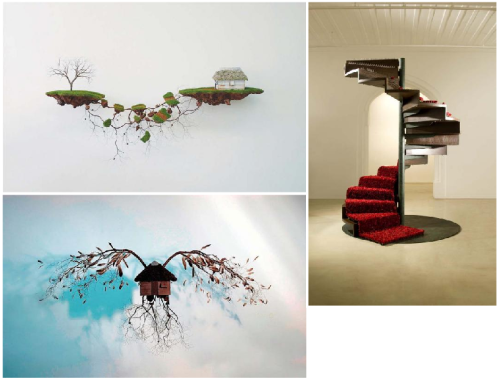
Details on the Sakshi Gallery website.
Filed under: Indian Art | 5 Comments
Tags: Sakshi Art Gallery, Scratch, Swapan Seth
Architecture competitions have their fair share of debates on efficacy and final output, but realised projects like the Pompidou Centre and Maya Lin’s Vietnam Memorial have had a profound impact on the relevance of competitions. The quality of the jury, conviction of the brief and whether the project sees the light of day are crucial in this debate. It is gratifying to see a competition in India that promises this and more.
THE SPIRETEC COMPETITION: An architectural design competition for a 62,750 square metres mixed use area that is part of an IT office complex spread across 85,000 square metres of land; with a built potential of 1,75,000 square metres. The complex is in Greater Noida; part of the Delhi – National Capital Region (NCR). The NCR is spread over an area of 33,578 square kilometres. It is the ninth largest urban agglomeration in the world. The site for the SPIRETEC project lies adjacent to the flood plain of the river Yamuna.
THE INTENTION: To foster an architectural debate that will influence main stream architecture in the country, to examine newer ideas relevant to design and sustainability in the context of India’s new urbanity, and to set extremely high standards of both transparency and quality of assessment in this competition and for such efforts in future. The project already has financial closure and will be built in the next few years.
THE JURY: Ajoy Choudhary, Aniket Bhagwat, Ashish Bhalla, Kai Gutschow, Ken Yeang, Lucien Kroll, Michael Sorkin, Peter Bosselman, Peter Head, Pradeep Sachdeva, Sanjay Prakash, Suparna Bhalla, Tay Kheng Soon.
THE AWARD: Up to five honourable mentions will get an award of US$10,000 each. Three winners will get an award of US$25,000 each. The AOD shall receive a contract of US$250,000.
Details of the competition are enclosed in this pdf – The SPIRETEC Competition Brief and can also be accessed via the website.
Filed under: Indian Architecture | Closed
Tags: Architecture, SpireTec Competition
Experimenter, the only gallery from India exhibiting at the Frieze Art Fair in London this October.
FRIEZE ART FAIR, London, 14-17th October 2010
Fair Opening hours: Thursday 14 October: 11am-7pm, Friday 15 October: 11am-7pm, Saturday 16 October: 11am-7pm, Sunday 17 October: 11am-6pm.
Filed under: Indian Art | 2 Comments
Tags: Experimenter, Frieze Art Fair, Prateek Raja, Priyanka Raja
Bombay Electric | 1 Reay House I Best Marg I Colaba I Mumbai +91 22 2287 6276 http://www.bombayelectric.in
Filed under: Indian Art, Indian Jewellery, Indian Photography, Indian Stores | 1 Comment
Tags: Bombay Electric, Little Shilpa
Now Showing > Say Everything
Filed under: Indian Art | Closed
Tags: Prateek Raja, Priyanka Raja
Invited > IFA and You Tube Play
India Foundation for the Arts (IFA) is an affiliate of the Guggenheim Museum on the YouTube Play project and invites you to submit videos to YouTube Play. A Biennial of Creative Video.
The deadline for submissions is July 31, 2010.
How to Participate: Through July 31, 2010, participants are invited to submit new or existing videos created within the last two years at youtube.com/play. Submissions may include any form of creative video, including animation, motion graphics, narrative, non-narrative, or documentary work, music videos, and entirely new art forms.
Selection Process: After the submission period closes, the Guggenheim Museum will identify up to 200 videos for online viewing at youtube.com/play. From this group, up to 20 videos will be selected by a jury of experts, comprised of distinguished artists, filmmakers, graphic designers, and musicians, to be presented at the Guggenheim Museum in New York during a special event on October 21, 2010, on view to the public October 22–24, with simultaneous presentations at the Guggenheim museums in Berlin, Bilbao, and Venice.
Filed under: Indian Films | Closed
Tags: Guggenheim, IFA, Play, You Tube
Showing > The Doorway
A year ago, in the living room of Jyoti’s apartment, I watched her perform The Doorway for an audience of one – me. It stirred me, in a way that I could not understand or place words to. It is an intense, involved experience and the interpretations are as much ours as hers. The project was funded by India Foundation for the Arts under the Extending Arts Practice programme and is being performed this weekend in Bangalore.
Filed under: Indian Expression | 2 Comments
Tags: IFA, Jyoti Dogra, The Doorway
Showing > This is Unreal
Filed under: Indian Art | Closed
Tags: Experimenter, Kolkata, Prateek Raja, Priyanka Raja
British Council India’s Creative Economy Unit runs the Young Creative Entrepreneur Award which is conducted across sectors including design, fashion, interactive and communications (including graphic design). The aim being to reward creative entrepreneurs based in India for contribution to their respective sectors. The YCE award programme goes beyond recognising the achievements of these entrepreneurs by providing them a platform to begin a dialogue with their UK counterparts. Entries are open till 10th July 2010. For more information, visit the website.
Filed under: Indian Craft, Indian Graphic Design, Indian Product Design | 20 Comments
Tags: British Council, Young Creative Entrepreneur Awards
Fashion Feature > Mulmul
The fine muslins of Dhaka, then Bengal, India, were famous when Babylonian and Assyrian kings ruled Western Asia. They were among the wares first brought to England and America by the old East India Company. Mulmul or Mull, as fine muslin is called in Hindi, is a very finely spun cotton yarn. It is light, soft against the skin, has a lovely fall and breathes well, thus making it ideal for hot, humid and dry weather.
A Fine Arts graduate, Puja Chodha moved from Bangalore to New York ten years ago. She conceived her brand Mulmul – comfy-chic loungewear – and founded her company pickypixie inc. in 2008. Her Spring Summer’10 launch collection, Waking Dreams, showcases no prints or colours – just a simple calm, handcrafted lounge-in feel, in what else but mulmul. Reminiscent in parts of Victorian India and at times the comfort of the white Kutchi kediyu and parsee sadras. A sensuous yet sensible wardrobe for an Indian summer, anywhere in the world. The only thing missing, perhaps Lakshmi Menon. Presenting the delicacy and beauty of Mulmul.
Filed under: Indian Craft, Indian Fashion | 17 Comments
Tags: mulmul, Puja Chodha
Shout Out! Art of the Book
Book cover design in India has a long organic history. Many of the early Punjabi, Bengali, Tamil, Malayalam, Hindi and Urdu literature book covers were stunning, sublime and ‘graphic’ even before that word became stylish. So the legacy is a formidable one. Among the newer sets, Amar Chitra Katha and Tara Books have some beautiful covers. Though often, contemporary Indian book design has been more ‘inspired’ than rooted.
The act of defining becomes so much more important for independent publishers. To celebrate the art in their book covers, Seagull Publications presents ‘The Art of the Book – Digital Collages by Sunandini Banerjee, Senior Editor and Graphic Designer, Seagull.’. Opening Saturday, 19 June 2010, 6.30 pm at the Seagull Arts and Media Resource Centre. If in Calcutta, do attend and of course, you’re encouraged to judge these books by their cover. Smile.
Filed under: Indian Books, Indian Graphic Design | 2 Comments
Tags: Seagull Publications, Sunandini Banerjee, The Art of the Book
Design Feature > Runjhun Jain
A graduate of the College of Art – Delhi, Runjhun is an ex-advertising creative director who doodles, styles ad shoots and loves creating, in her own words, ‘easy, quirky and honest’ designs. Her maiden collection of cushions uses dori work, chawal tanka and applique to translate her doodles onto fabric. “I was sure I didn’t want to simply transfer my drawings as line prints onto cloth, that for me didn’t complete the step over to a new medium. I wanted to explore textures, embroidery styles, stitches and still retain the madness and innocence of my art. Each cushion has been worked upon by kaarigars on my original line work.” The pieces are charming, well-finished and have an individual style. Presenting Runjhun Jain’s delightful experiments with embroidery and applique.
Filed under: Indian Art, Indian Craft, Indian Graphic Design | 15 Comments
Tags: Applique, Cushions, Doodles, Indian Embroidery, Runjhun Jain
Jewellery Feature > Hanut Singh
The burgeoning Rs 1-lakh crore domestic jewellery industry in India is testament to the importance Indians place on their jewellery. Where once it was the preserve of family jewellers and trust was gained over many generations, the emergence of jewellery designers, independent and those designing for jewellery houses, has today egged people to experiment and accessorise as never before. Featuring independent designer Hanut Singh, whose jewellery reflects grace, quiet grandeur and a traditional Indian spirit. Hanut seems to design to flatter rather than overwhelm the wearer and his creations are versatile enough to be worn over almost anything, at any moment, for any occasion. The grandson of late Maharaj Kumar Karamjit Singh of Kapurthala, Hanut has no formal training, his early influences being the Cartier and Van Cleef and Arpels jewellery commissioned and owned by his family. Presenting a selection of his work and thoughts.
Filed under: Indian Jewellery | 15 Comments
Tags: Hanut Singh, Indian Jewellery
Just spotted > Wearabout
A few months ago, I stumbled across an interesting Indian blog, Wearabout, that documents Indian street fashion, individual style and the work of 26 year old photographer Manou, who runs it. He has a good eye for colours and an ability to find something aesthetic in everything. Here are a few images from the blog.
> On the Indian Street
Filed under: Indian Fashion, Indian Photography | 7 Comments
Tags: Indian Photography, Indian Street Fashion, Manou, Wearabout
Poet, Novelist, Playwright, Musician, Artist, Nobel Laureate, founder of ‘Vishwa Bharti’. This year marks the 150th anniversary of Rabindranath Tagore. Born in 1861, Tagore turned artist at the age of 67 experimenting with various mediums. Tagore said of his art, “People often ask me about the meaning of my pictures. I remain silent even as my pictures are. It is for them to express and not to explain.” On June 15th, Sothebys is set to auction 12 of his paintings. And it has caused much furore in the sub-continent. Presenting a few of his pieces.
Filed under: Indian Art | 5 Comments
Jewelry Feature > Puja Bhargava
Puja Bhargava graduated in Accessory Design from NIFT, Delhi (1997) and is a certified Gemologist. This is an assorted collection of her jewelry. The string of parrots is my favourite of the lot.
Filed under: Indian Jewellery | 14 Comments
Tags: Puja Bhargava
Archi Feature > Mewar Complex
The Mewar Complex is dedicated to Rana Pratap (1540-1597), who fought for a free kingdom when numerous Rajput Kings were forming alliances with the Mughals. Being always at war, Rana Pratap didn’t have time to build anything in his name. The Rajasthan Tourism Development Corporation aims to redress that.

Why do we make memorials? Perhaps we want to anchor a visual memory to a place, like we do with photographs in our wallets, so that its constant existence turns it immortal. But what determines the shape public memorials will take? The ones we see in India, Vijay Stamb, India Gate, Gateway of India, Victoria Memorial and around the world, the famed holocaust memorials, the Hiroshima memorial, the pyramids – their character is defined not just by their content or purpose, but also by the politics, belief and mindset of that time.
Long before the Taj Mahal was a tourist attraction, it was a memorial that stood by the waters of the Yamuna, protected by its walls and nothing else. It was not a place to live in, a fortress to secure anything, it was a memory located somewhere, and by being there, it changed the view of the horizon, evoked a new meaning.
Traditionally, memorials in Rajasthan were mostly chhatris (canopy) – elevated, dome-shaped pavilions which paid homage to the dead. The larger ones had multiple rooms and the interiors walls were at times decorated like those in Havelis. Located by the river or the road, these have over time become journey markers and reborn as community spaces for people to meet or spend time in.
The Mewar Complex is a loose cluster of three main memorials – Yuddh Smarak, Vijay Smarak and Raj Tilak Sthal. Each commemorates a specific event, serving to narrate the story of Rana Pratap’s life in chapters. The Complex alters the desert landscape for those who pass by. What are we to make of them? How do they affect our interaction with the desert and the countless stories buried in the sand? Does a memorial commemorating Rana Pratap need to look like how he would have built it in war-torn feudal times, or how we see him in our democratic present? Does the past need to be represented as a mime or as an understanding? Much of this forms the conversation with one of the architects of the project, Meghal Arya. But first, a look at the Mewar Complex itself.
Filed under: Indian Architecture | 7 Comments
Tags: Indian Architecture, Meghal Arya, Mewar Complex, Minakshi Jain Architects, Rajasthan Tourism Development Corporation, Rana Pratap, Vijay Arya
New @ Tara Books
More on their website.
Filed under: Indian Art, Indian Books | Closed
Tags: durga bai, Gita Wolf, Tara Books
I support > Spade – Vol. 2
SPADE is a biannual journal that deliberates on architecture and design in India. Vol 1 was a treat to read as well as to look at. An absorbing, thought-provoking set of articles, extremely well-typeset, well-photographed. Written and put together by professionals in the field of architecture and design, this peer-driven journal has been so far made it to Vol. 2 thanks to the tenacity and sheer will of the editors and contributers. It features no ads and receives no external funding. And needless to say, requires all the support it can get. SPADE intends to persevere at being an egalitarian voice of the discerning architectural community in India. Journals such as these are precious in their intent and integrity – I urge you all to heartily support SPADE.
Vol. 2: Of Architecture and Reincarnation
“The idea of reincarnation is inexplicably linked with the idea of death. One cannot exist without the other. How does one examine this idea in the process of civilization and mankind? Do civilizations really die or through their ideas stay alive?”
Edited by Samira Rathod and Aniket Bhagwat. Contact spadeindia@gmail.com or call +91 22 24327249/24310395 or fax +91 22 2432 4349 for your special offer copy*.
India: Rs 600, Euro 15. *Special offer: Rs400 (Valid till June 15, 2010 – postage and handling charges extra)
Issues so far:
Vol 1: Of Architecture and Politics,
Vol 2: Of Architecture and Reincarnation
Forthcoming:
Vol 3: Of Architecture and Collage (Jan 2011),
Vol 4: Of Architecture and Opium (Dec 2011)
<Read the earlier Indian By Design post on Spade here.>
Filed under: Design Criticism, Indian Architecture, Indian Books, Indian Craft, Indian Design Criticism, Indian Interiors, Indian Photography, Indian Research | 6 Comments
Tags: Aniket Bhagwat, Samira Rathod, Spade
Designers at Honeywell Technology Solutions in Bangalore, Ankur Sardana (NID) and Parag Trivedi (IDC), have created a self-diagnosis tool for people living in rural India. The design is simple, efficient, made with recycled materials to keep costs low, and aims to empower patients and help doctors by aiding patients to accurately identify their symptoms. In conversation with Ankur Sardana on why he and Parag created the tool and the role it seeks to play in the accurate diagnosis and efficient recovery of patients all over India.
Continue reading ‘Product Feature > Low-cost self-diagnosis tool for rural India’
Filed under: Indian Product Design | 19 Comments
Tags: Ankur Sardana, Bangalore, Honeywell Technology Solutions, Low Cost Self Diagnosis Tool, Parag Trivedi, Rural india
‘Arna-Jharna’ means ‘forest’ and ‘spring’. Unlike most museums where what is of value is encased inside, Arna Jharna includes the desert, its environment and its inhabitants as its exhibits. Created by the late Komal Kothari, one of India’s leading folklorists and oral historians, the Arna-Jharna Museum is an interactive learning experience linked to traditional knowledge systems.
Continue reading ‘Research Feature > Arna Jharna, the desert museum’
Filed under: Indian Craft, Indian Research | 3 Comments
Tags: Arna Jharna, Broom Exhibition, Desert Museum, Komal Kothari, Rajasthan
We, the urban elite, are today much more aware of the term ‘design’ than we were twenty years ago. In olden times, objects were attached to the expectation of value. Today it is foremost the accumulation of style, the act of surrounding the world around us with beautiful things. And that is the new meaning of value for us, an imperceptible cloud of wants.
The designer has taken on a hallowed role, more akin to an artist, and the profession is generating a tornado of importance around itself. The word Design, as journalist Rob Walker says in Objectified, has become amorphous with good design. He adds, that’s like saying writing is good. But the real question is, what are you trying to say?
Continue reading ‘Design Speak > The landfills of wants and desires.’
Filed under: Design Criticism | 6 Comments
Tags: Design, Desire, Want
Anokhi, a brand that has worked for over 30 years to revive Rajashthan’s traditional techniques of block printing. Created by Faith Singh and J.P.`John’ Singh and now run by their son Pritam Singh, they develop products in specialised areas such as appliqué, embroidery, patchwork and bead work, which now constitutes a significant part of their product range. Together with garments – Indian and Western in design – home textiles, sarongs and accessories, Anokhi offers a diverse and colourful selection of products.
Continue reading ‘Fashion & Research Feature > Anokhi and the Anokhi Museum of Hand Printing’
Filed under: Indian Craft, Indian Fashion, Indian Research, Indian Stores | 20 Comments
Tags: Amber, Anokhi, Anokhi Museum, Block Printing, Indian Hand Printing, Jaipur
I was arrested by the images. The colors and the contrast, the photography, the choice of Indian classical dancers as models, the old world feel and a body language of so much comfort, like we chanced upon two friends enjoying a quiet afternoon and kept watching them because it was poetic. I am happy to present, Calantha Wardrobe’s Vintage Sari collection.
Filed under: Indian Fashion, Indian Photography | 18 Comments
Tags: calantha wardrobe, Chitra Kala Parishath, Indian Fashion, Madhuri & mayuri Upadhya, roopa pemmaraju, sari, Sunitha Nadig, Yanie Nor
I came across Travelling Tent Cinemas last year when it was mentioned on the list of IFA grants. Found links on the web which led to a series of images that brimmed with drama, atmosphere and a story worth telling. Presenting a few images from the series and a conversation with photographer Amit Madheshiya.
Filed under: Indian Photography, Indian Research | 9 Comments
Tags: Amit Madheshiya, Shirley Abraham, Tambu Talkies, Tent Cinema in Maharashtra
Craft Maps > Dastkar Haat Samiti
The Dastkar Haat Samiti organises crafts bazaars all over India. It has, over the last ten years, documented crafts and handloom textiles produced all over India, and created maps for each state. Here are a few of them.
> The Maps are available for sale at the Dilli Dastkari Samiti’s shop in Khan Market, Delhi. For details on the maps and the activities of the Dastkar Haat Samiti, do visit their website.>
Map picture courtesy DHS website.
Filed under: Indian Craft | 3 Comments
Tags: Dastkar Haat Samiti, India Craft Maps, Indian Crafts, Indian Handlooms and Textiles
Jewellery feature > Suman Mishra
I was charmed by the simplicity of her pieces. Suman Mishra captures the first signs of spring in her new collection. Mishra says that her creations are not ethnic, but often inspired by traditional silhouettes and motifs. She lives next to the Delhi Ridge forest and explorations of the forest (with her two dogs in tow) refresh and inspire her.
Filed under: Indian Jewellery | 8 Comments
Tags: Indian Jewellery, Suman Mishra
Published > Raja Ravi Varma
“This book by Rupika Chawla is an account of Ravi Varma’s traditional background and environment in the context of colonial India, and the relationship of this milieu with his profession as an aristocratic itinerant painter. This lavishly illustrated book brings together paintings from royal and private collections and museums, and works that have never been seen before, along with previously undisclosed maps, letters, photographs and other archival material. It traces the sources used by him, examines the techniques and methodology of his paintings, and discusses their conservation and the problem of fakes and copies.”
> Rupika Chawla is a conservator of paintings based in Delhi. She has restored several Ravi Varma paintings at her studio in Delhi and she also gives training in conservation. Together with artist A. Ramachandran she organized the seminal exhibition on Raja Ravi Varma in 1993 at the National Museum, Delhi, which brought about a strong revival of the artist and his work. More on the mapin website. <
Filed under: Indian Art, Indian Books | 4 Comments
Tags: Mapin Publishing, Painting Indian Royalty, Raja Ravi Varma, Rupika Chawla
History is reconstructed by what is left behind – the notes, drawings, pictures and artifacts that tell the tale of a time gone by. The objects by themselves are like museum pieces that provoke interest but it’s only when the stories behind their being are shared that they turn magical. Through the Indian Memory Project, Anusha Yadav attempts to trace the history of Indian settlements and cities through pictures found in personal family albums and archives.
Anusha is partial to history, pictoral history in particular, and was brought up in Jaipur where she says most family albums looked like royal portraits. A photographer by profession, she terms her work as Urban Documentary. And also plans to start a family/corporate picture archiving service which archives all information digitally for future generations. She shares a few pictures from The Indian Memory Project.
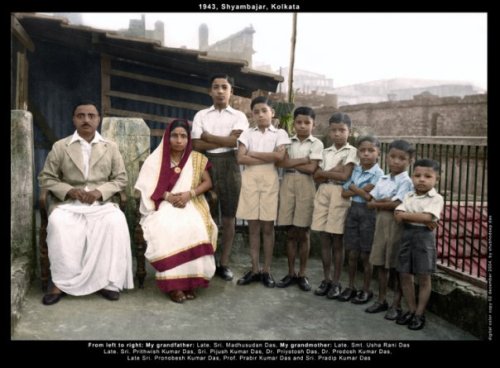 Continue reading ‘Research Feature > The Indian Memory Project’
Continue reading ‘Research Feature > The Indian Memory Project’
Filed under: Indian Photography, Indian Research | 9 Comments
Tags: Anusha Yadav, The Indian Memory Project
Priya Kishore says “Found objects, precious gems and flouro baubles by India’s underground jewelers Meenakshi Dash, Martinaa New and Fanny Boucher make their first debut in an Indian store from 2nd-6th March, 2010. The exhibition, entitled UNDERGROUND JEWELS features directional, fashion forward pieces for the elegant intelligentsia, disco aunties, and wild at heart.”
> 2nd-6th March, 2010, Bombay Electric, 1 Reay house, BEST marg, Colaba, Mumbai, 400 001 INDIA
Filed under: Indian Jewellery | 3 Comments
Tags: Bombay Electric, Fanny Boucher, Martinaa New, Meenakshi Dash, Underground Jewels
Typographica and Seminar: On 17th Feb, W+K Exp, Delhi will showcase the world of Seminar Magazine, India’s own groundbreaking testament to the power of the word. Celebrated over its 50 years for bringing “opposing viewpoints within the covers of a single magazine”, this exhibition does not delve into the content of the magzine, rather it focuses on the magazine’s unequivocal support of typography – Seminar has appeared every month since its inception with a purely typographic cover. Curated by its current designer, Akila Seshasayee, and owner editor Malvika Singh, the exhibition will present the best covers from 50 years of the magazine. Also showing, is Typographica, the first exhibition of the design journal of the same name. Groundbreaking when first published in 1949 and now considered legendary, Typographica showcased the very best in worldwide visual arts. More details on www.wkexp.com Picture of cover courtesy Sesh Design.
Continue reading ‘Three Exhibitions > Seminar Mag, Her work is never done, Empire Strikes Back’
Filed under: Indian Art, Indian Graphic Design | 1 Comment
Tags: Empire Strikes Back, Gallery BMB, Her work is never done, Saatchi Gallery, Seminar Magazine, W+K Exp
*An Indian By Design Exclusive*
Herman Melville once said ‘They talk of the dignity of work. Bosh. The dignity is in leisure.’
Built over an old outhouse, the Garden Lounge, created by M/s Prabhakar Bhagwat with interiors by SRDA, is a private space of leisure, a retreat, built to step away from everyday living. A short walk from the main home, it is a hideout within the large grounds, flanked by trees, a sunken garden and a cool blue pool. This post walks through the structure, landscape and interiors of the lounge – all of which are strongly voiced and distinct – and explores to see if they work to bind or alienate the sense of leisure.
Filed under: Indian Architecture, Indian Interiors | 13 Comments
Tags: Ahemdabad, Akalpya, Aniket Bhagwat, Furniture, Indian Architecture, Interiors, Landscape, Lounge, Prabhakar Bhagwat, Samira Rathod, Smruti Bhagwat, SRDA
Chhau is a dance-drama form prevalent in Eastern India. There are three major forms of Chhau, each known by its geographic location. These are Purulia Chhau of West Bengal, Mayurbhanj Chhau of Orissa and Seraikella Chhau of Bihar (now Jharkhand). Although they are all known as Chhau, their styles differ considerably in terms of their cultural background and their dance characteristics. The festival will feature some of the most outstanding exponents representing each of the three traditions.
Keli Festival, scheduled on the 28th, 29th and 30th January 2010 at YB Chavan and Prithvi Theatre, will feature the different traditions of Chhau Dance.
Free Passes at Rhythm House & Giri stores, Matunga, three days prior to the festival. Mail Mr. Ramachandran, ramk.keli(at)gmail(dot)com, for further details.
Filed under: Indian Expression | 5 Comments
Tags: Chhau Dance, Eastern India, Keli Festival
“Artistically, terracotta is the medium where many ideas were first experimented upon before they were committed to stone. At the same time, Many of these artefacts were used in ephemeral rituals and then discarded; their study thus permits an insight into those aspects of religious worship little studied in a field where the emphasis has been on monuments of more durable material. Inexpensive and easily replaced, terracottas are by their very nature a source for a unique telling of a more quotidian history, reflective of religious cults worshipped in peoples’ homes rather than the grand stone temples.
This course looks at issues of mass-production in Ancient societies, the dissemination of religious iconographic models and objects that reveal that art in Ancient India was not merely sacred. This course delves into one of the fundamental elements of Indian visual culture.”
Conducted by Naman.P.Ahuja, Associate Professor of Ancient Indian Art & Architecture at JNU.
Course Dates and Timings – 17th, 18th & 19th February, 5:00 pm – 9:00 pm
Registration opens 25th january, public fee: Rs 1000, MU student fee: Rs 250, Limited seating.
Jnanapravha organises courses and talks on a regular basis. Read more about them on their site. More information on Terracota research is available here. Image courtesy Jnanapravha.
Filed under: Indian Architecture, Indian Art | 1 Comment
Tags: Jnanapravaha, JNU, Naman P Ahuja, Terracota Research
Shout Out! > Design Kashmir
Filed under: Indian Craft, Indian Stores | Closed
Tags: Bombay, Design Kashmir, Priya Kishore
Filed under: Indian Photography | 1 Comment
Tags: Bijoy Jain, Edge of Faith, Prabuddha Dasgupta, Priya Jain, Tasveer
Aakash Nihalani is a Brooklyn based artist who works with the medium of tape in public places around New York.
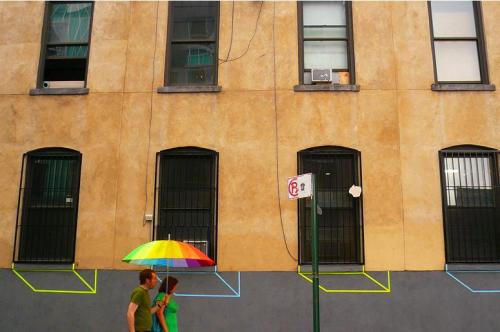
Continue reading ‘Caught my eye > Aakash Nihalani’s Tape Art’
Filed under: Indian Art, Indian Guerilla | 8 Comments
Tags: Aakash Nihalani, Tape Art
Bikram Mittra’s Weave Stool is constructed out of a single laminated member that is repeated to create a ‘weave’ effect.

Filed under: Indian Product Design | 5 Comments
Tags: Bikram Mittra, Weave Stool
By Lotus Design. I saw this a long time ago on Ambrish’s laptop and have looked forward to featuring it since. The simple use of paper and colours brings back memories of the paper windmill sellers and makes the mela so festive.
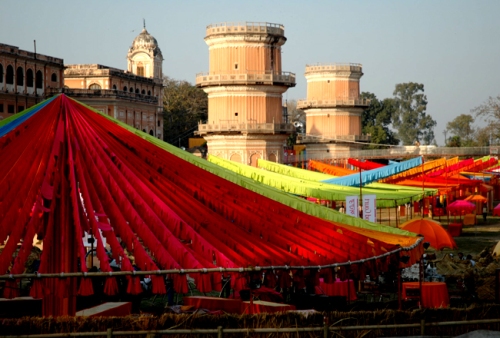
Filed under: Indian Craft | 8 Comments
Tags: Festive, Indian Mela, Lotus Design, Patiala Craft Mela
My Speak > Good Design
What is good design? This gmail inbox I’m writing in is. The keyboard I’m typing on isn’t. My body is. A waterfall is. An Indian mud pot with a tap attached to it is. None pretend to be what they are not. And work wholeheartedly towards being purposeful with intent to be of use.
Must all good design be of use? I would say yes. Or it isn’t design. It is art. Created to please, to extract emotions perhaps, and to make a point. A luxury. A pursuit for creative minds. Beautiful. Arresting. But not design in itself.
Canvas is good design. Is non porous, resistant to wear and tear and is strong and easily molded into anything. The art on it may or not be depending on what purpose it seeks to serve, what its intent is – the toothbrush vs. the Mona Lisa. I think the toothbrush is better design. But I think a stick of Neem is even better. It isn’t wasteful. Does the same job and more and is sensitive to its surroundings. Comb vs. hands. Hands are better. Multi-tasking and a sustainable resource.
If the world were to maximise what is already given by nature, our bodies included, than we would require very few new things to be designed all over again. Often when we design, we mimic, and dress it up, like fireworks on a starry night, only it’s a show, and has no real substance, and often no improvement over the master design.
The master design. Good design is a quest for the master design. The unshakeable mould. The way to get somewhere in the most efficient effective, sensitive, insightful way possible.
Good design is like a good proverb. It survives generations and is important because it is useful. No one praises proverbs for the reasons they do poetry. Proverbs are storehouses of information and experience; whether they please or do not please, they rarely fail to be effective. So too of good design.
If it’s all so simple, then why is so difficult to comprehend. Why do we confuse decoration for design? Perhaps because we are not geared to understand simple. Because we understand complex things like art far more easily than we do design. We look and say, ah pretty, it moved me, it made me cry. But ignore the most perfect designs like step wells and the thumb. Art is open to view points, and therefore more democratic, such that it allows everyone an interpretation. A tree has no interpretation. It just is. It exists in variations of the same design. In various types and forms. Roots. trunk. Leaves. fruits. Seeds. You cannot say you hate good design. Because its nature of being purposeful makes it immune to judgement. You could hate good art though. Like a salt and peppershaker. All have holes. Though the shapes and forms change. The perfect design was the holes. Everything else is dressing.
The best way to judge/measure/evaluate design is to put it to use, see what like it has been done before, and what new has been explored in this version, for it will or is usually a version, see how sensitive it is to the environment it is created for.
Design is negative space – for it is not an end in itself. It exists to fulfill a need. The moment you recognise the negative space, you start to see the real outlines of design. And then your eyes will never be muddled with mere decoration again.
Filed under: Design Criticism | 16 Comments
Tags: Design Vs Art, Good Design, My Speak
Caught my eye > Kaali and Klove
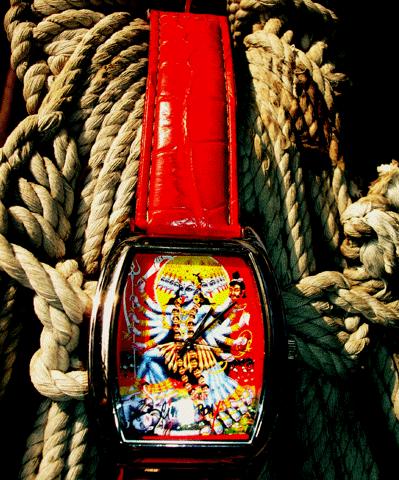
Kaali Watch by Cimmaron Singh
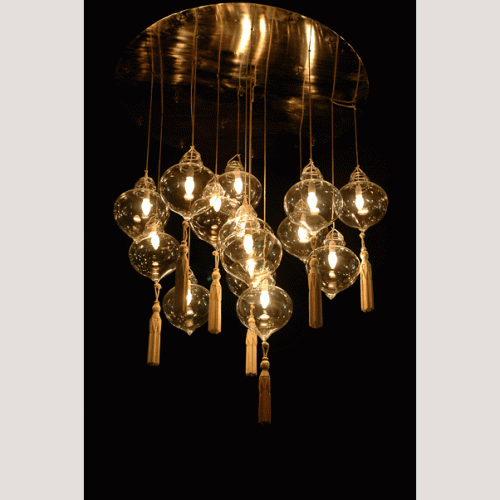
Moroccan Vase Chandelier by Klove
> Part of a Religare Arts Initiative exhibition held in Jan 2009.
Filed under: Indian Art, Indian Product Design | 15 Comments
Shout Out! > Mithila Artists
The last known authentic Mithila artists, Satya Narayan Lal Karn and Moti Karn are exhibiting at Jamaat Art Gallery till October 7th. Do catch the show.
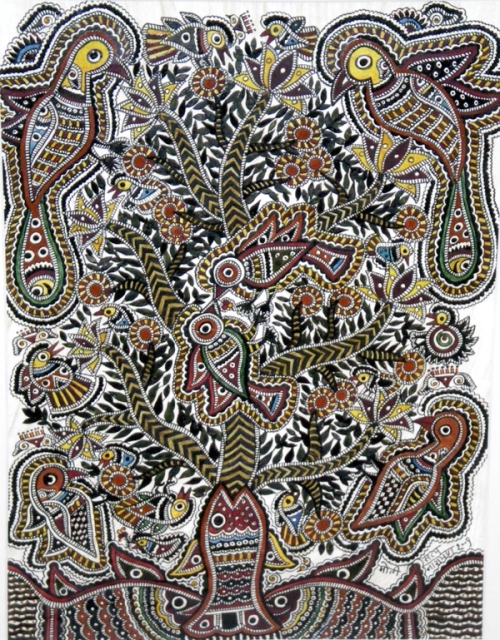
Thank you Dev.
Filed under: Indian Art | 1 Comment
Tags: Indian Art, Jamaat Art Gallery, Mithila Artists, Moti Karn, Satya Narayan Lal Karn
New Release > Do!
Tara Books has a new release. DO! It’s a wonderful way to integrate Indian art with education without making it too complicated. Here are some pages from the book.
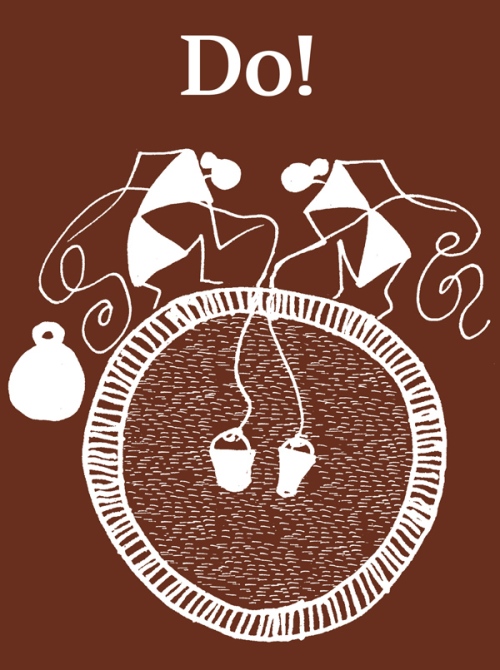
Do Book Cover
Filed under: Indian Art, Indian Stores | 8 Comments
Tags: Do!, India Tribal Art, Kusum Dhadpe, Ramesh Hengadi, Rasika Hengadi, Shantaram Dhadpe, Tara Books, Verbs, Warli Art
*An Indian By Design Exclusive*
M/s Prabhakar B. Bhagwat founded LEAF (Landscape Environment Advancement Foundation) to engage in research and publication in the area of landscape design and environmental planning. It supports research programs of varying durations every year. The first of which is “Seeing the City” by Parin Shah, a student of Landscape Architecture.
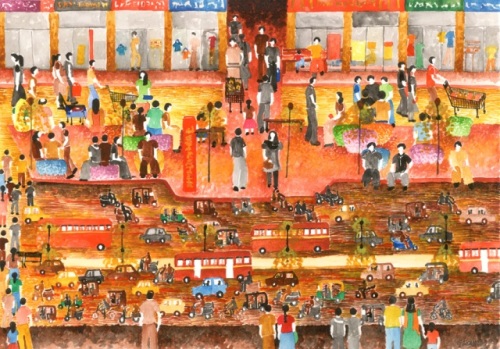
Parin’s study on ‘Seeing the City’ is a subject close to my heart, that I believe requires plenty of discussion and action. There are increasingly no spaces one can spend time in that do not require one to spend money in. India’s idea of development is distorted – with no celebration or extension of the way our society grew, instead a blind embrace of the western – measured by shopping malls and hypermarts housing international brands and sales rather than the creation or continuence of chowk and maidaan like nourishing public spaces.
“Where do Amdavadis go out?” Parin attempted to answer this question. While doing so, she used the medium of water colours to capture the spirit of the city rather than just rely on a passive photograph. She observed locations, walked through streets studying the way people behaved and selected eight places. She then painted them in a manner where she laid more emphasis on some arrangements or aspects that she believed influenced the perception of the place. Presenting “Seeing the City”
Filed under: Indian Architecture | 11 Comments
Tags: LEAF, M/s Prabhkar B Bhagwat, Parin Shah, Seeing the City
Design Feature > Batootas
Found Roshnee Desai on Deviant. It led me to her blog and her Batoota cushions. They were quirky and an observation of the behaviour around us.
Roshnee says: “The Batootas are creatures which infest your daily mundane objects by redefining them and while doing so, passing a social comment, using puns.”

COO SHUN
Roshnee says: “They’re at Chowpatty. They’re on bikes. They’re hiding under behind trees. They’re where you least expect them. They sit at Bandstand. They stand at Banstand.Thats one thing they have in common. The incessant cat-mouse chase of the coo-ers and the shoo-ers. PDA. Police Dandaa Abruption. Coo Shun. Shun the coo. You can run you can hide but you cant escape my love.
Filed under: Indian Design, Indian Product Design | 14 Comments
Tags: BATOOTA, COO SHUN, ROSHNEE DESAI
Sanjay Patel is an animator and storyboard artist at Pixar. Came across his website and work GheeHappy on Pardon My Hindi. Tiny happy illustrations of Indian Gods, very child- friendly.

> More of Sanjay Patel’s work on his site.
Filed under: Indian Graphic Design | 4 Comments
Tags: Ganesha, GheeHappy, Krishna, Shiva, The Little Book of Hindu Dieties
I support > The Uniform Project
* An Indian By Design Exclusive*
1 dress. 365 days. I found The Uniform Project via the wonderful Sub Studio blog. What began as a sustainable fashion project turned into an ingenious fund raising campaign – the billboard being the creator herself. Sheena Matheiken uses her quirky sense of style to wear the same tunic again and again, and will do so for a year. Proceeds of the Uniform Project will go to fund school uniforms and educational necessities for children living in slums in India. The exercise is fun and challenging as well. Each ensemble has a name, visitors can rate its fashion quotient, and there’s also the curiosity of what more could she possibly think of! We all want to do good, and often that stays in our mind, because it seems like to do good, we need to quit our jobs and wear cotton kurtas and live in a village. But Sheena and her uniform designer Eliza have shown that we could do a lot, right where we are, just by using our ingenuity. I support, wholeheartedly.
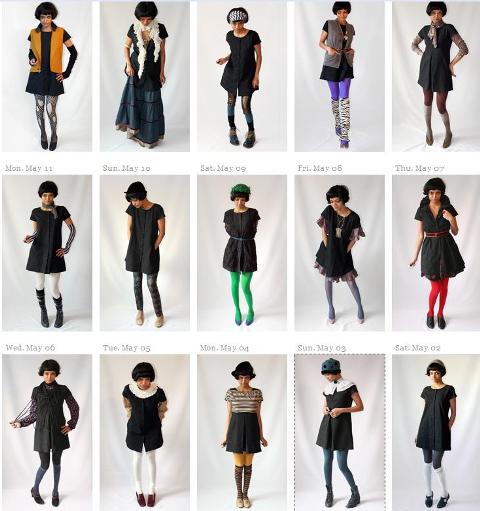
Sheena says: “Starting May 2009, I have pledged to wear one dress for one year as an exercise in sustainable fashion. Here’s how it works: There are 7 identical dresses, one for each day of the week. Every day, I will reinvent the dress with layers, accessories and all kinds of accouterments, the majority of which will be vintage, hand-made, or hand-me-down goodies. Think of it as wearing a daily uniform with enough creative license to make it look like I just crawled out of the Marquis de Sade’s boudoir.”
Filed under: Indian Fashion | 9 Comments
Tags: Akanksha Foundation, Eliza Starbuck, Sheena Matheikan, Slum Children, Sustainable Fashion, The Uniform Project
Design Feature > Doshi Levien
*An Indian By Design Exclusive*
This post is months overdue. Here’s to the very patient Nipa & Jonathan who I am sure had an amazing showing at Milan, and to all the wonderful people who follow Indian By Design.
Purvi Sanghvi, jewelry designer and an ardent fan of Doshi Levien, introduced me to Nipa and Jonathan’s works. The London based design office led by the husband and wife team was set up in 2000 and has since amassed quite a reputation, most recently being awarded Best Domestic Design by Wallpaper magazine for their work – My Beautiful Backside. Their work is distinct, quirky, fun and very usable. The Doshi-Levien portfolio has plenty of Indian cultural bias coupled with a unemotional industrial bent. Something that makes their work truly progressive and modern for me. Their work includes installation design for the Wellcome Trust, interaction design for Intel, insight and design direction for Nokia, product design for Tefal, furniture design for Moroso and bespoke shoes for London based “aristo” bootmakers, John Lobb. In conversation with Nipa Doshi.
> MOROSO CHARPOY
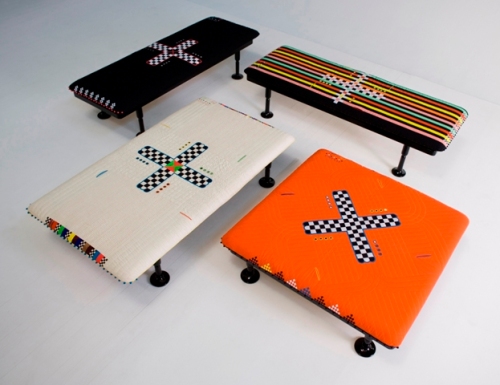
Nipa says: “A range of four daybeds called ‘Charpoy’ marry the skilled workmanship of Indian seamsters with Italian expertise in industrial production. Charpoy’ meaning 4 legs, is derived from the ubiquitous Indian daybed that recurs in several ‘Avatars’ or manifestations throughout the country; as a stringed bed to sleep on or a daybed for ladies to lounge on and conduct their daily affairs.
Filed under: Indian Craft, Indian Graphic Design, Indian Interiors, Indian Product Design | 21 Comments
Tags: Doshi Levien, John Lobb, Jonathan Levian, Moroso, Moroso Charpoy, Mosaic, My Beautiful Backside, Nipa Doshi, Pricipessa, Tefal, Wellcome Trust
Window Shopping > Ashima – Leena
The Ashima – Leena store is subtle, so much so that you might not notice anything but the clothes. But there are simple details that charmed me. The embedded designs that melt the cement floor as they vein out from the logo, the suspended silent busts that the clothes float on, the gold that adds richness to all the raw texture around.
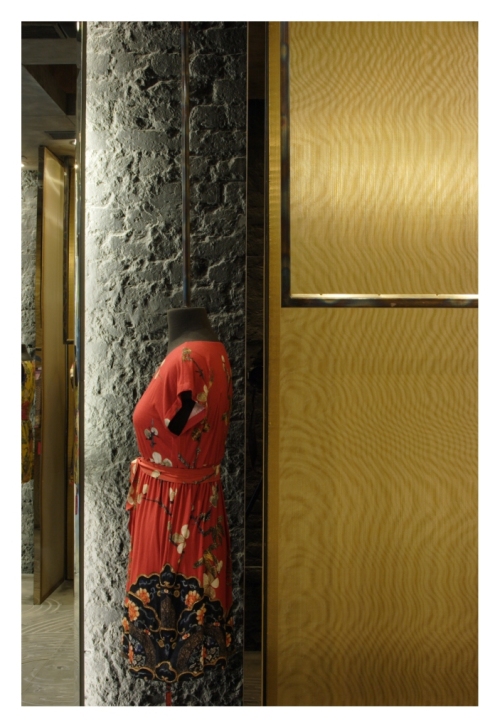
Filed under: Indian Fashion, Indian Stores | 13 Comments
Tags: Ambrish Arora, Ankur Choksi, Arun Kullu, Ashima and Leena, Itu Chaudhuri Design, Lotus Design, Sidhartha Talwar
Photographer Bharat Sikka’s Indian Men is a fascinating study of urban men from the sub-continent. I could imagine someone I’ve met, known or seen in each one of these photographs. Presenting his stirring series.
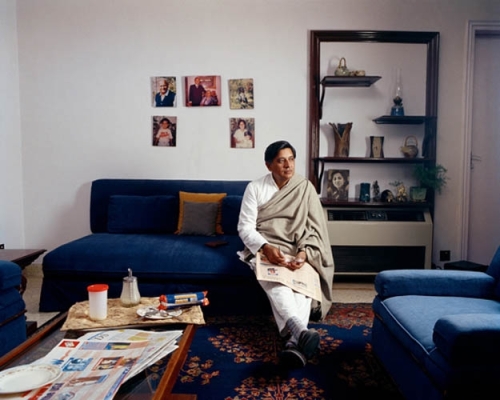
Continue reading ‘Photo Feature > Bharat Sikka’s Indian Men’
Filed under: Indian Photography | 15 Comments
Tags: Bharat Sikka, Indian Men, Indian Photography
Fashion Feature > Moyna Bags
Stumbled upon Moyna Singh’s work in Rivaaj Magazine. Liked her bags, especially the tomato red sequins, the emerald sequins and the blue and white and pink beaded one. Clicked through to her site and found it teeming with pages from Elle, Cosmo and Vogue where her bags have been featured. Here are some of my favourites from her collection.
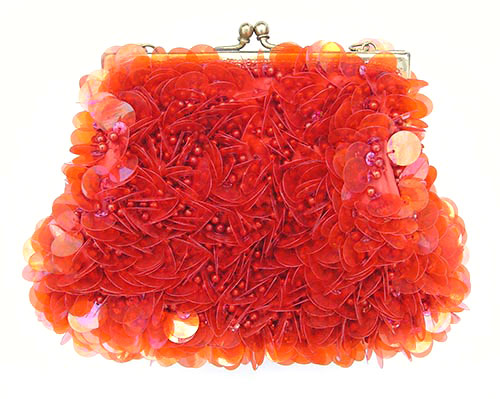
Filed under: Indian Fashion, Indian Product Design | 17 Comments
Tags: Accessories, Moyna Bags, Moyna Singh
Design Feature > Jugaad
Bhavik wrote to me asking ‘how come indian designs are not reflected in our highways and the environment? Am I missing something here?’ Felt that it was time to share the idea of Jugaad or Indian improvisation that is so ubiquitous. Bijoy Jain brought it up in his interview, saying that it’s something that fascinates him; his studio has taken several pictures of it as part of an ongoing research on Indian ingenuinity. We’ll never know who designed these, or what the reason for doing it this way was, just that it exists, and if we stop to stare, we’ll realise, it’s a great piece of design. And it’s been right under our noses all this time.
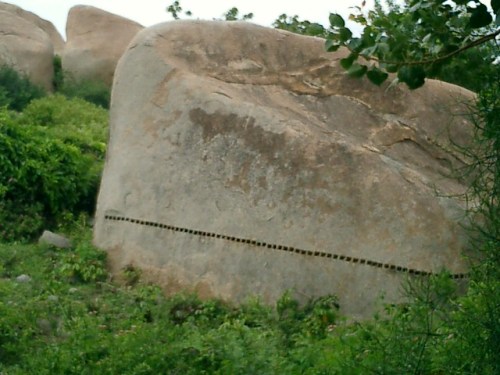
Rock Marks
Filed under: Indian Architecture, Indian Craft, Indian Product Design | 8 Comments
Tags: Bijoy Jain, Indian Ingenuity, Jugaad, Studio Mumbai
Design Feature > Design Temple
The Design Temple line of products are cleaned-lined and modern in design, but draw their inspiration from Indian myth, history and local nuances. There is a quirky, humurous take in each that doesn’t affect the functionality of the object. Here are some that caught my eye.
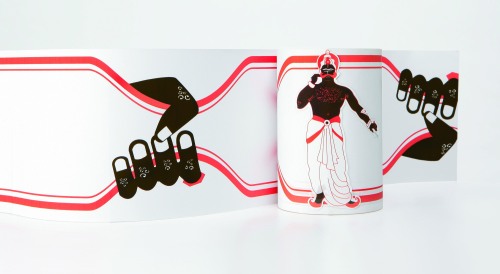
Cheerharan toilet paper
Cheerharan Toilet Paper:This hand-grabbing toilet paper is inspired by the evil king Duryodhana who ordered “Cheerharan” or stripping of the saree, in a famous Indian epic from the 4th century B.C. That saree never came to an end, this toilet paper will. Set of 2 rolls.
Filed under: Indian Graphic Design, Indian Product Design | 17 Comments
Tags: Design Temple, Divya Thakur
Memories of childhood are often about simple things; streets and lanes you grew up in, friends you spent time with and the games you played. Diptanshu Roy belongs to a joint family, grew up with 15 odd cousins living in the same house. As kids, they spent hours together, playing with simple toys, and that made them happy. Today, he says, it’s hard to come across kids playing with these toys. In these pictures, he captures the nostalgia of some simple and playful Indian games from his childhood.
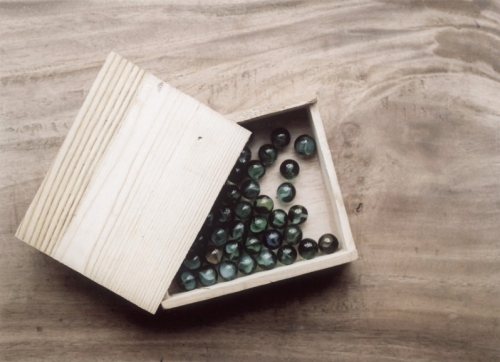
Marbles
Filed under: Indian Craft, Indian Product Design | 11 Comments
Tags: Diptanshu Roy, Indian Games, Indian Photography
Design Feature > Jenny Pinto
*An Indian By Design Exclusive*
Jenny’s work stems from the heart and her lamps seem to be lovingly nudged and caressed into form, the light brushing through and around it like wind. Featuring her work and thoughts.
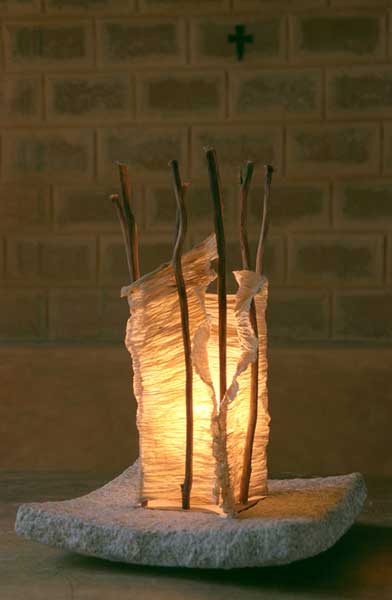
“Spider” Banana fibre paper, hand cut granite, twigs, 15”
Filed under: Indian Craft, Indian Interiors, Indian Product Design | 12 Comments
Tags: Bangalore, Handmade Paper, Jenny Pinto, Julie Kagti, lamps
*An Indian By Design Exclusive*
Presenting the first pictures of the new Rohit Bal Store, at Emporio in New Delhi. The store evokes a sense of grungy grandeur, and the gold and mirror and jaali work seem refined and edgy simultaneously. I enjoyed the way the store is filled with distractions, but the garments are still the focus of attention.
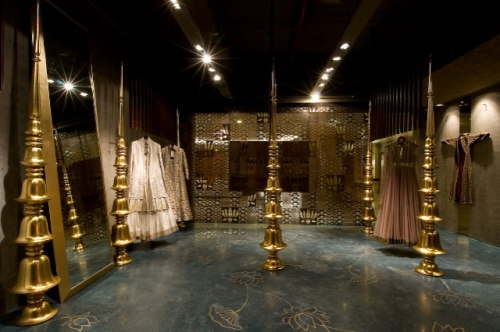
Click here to see more pictures. Continue reading ‘First Look! > The Rohit Bal Store, Emporio, New Delhi’
Filed under: Indian Interiors, Indian Stores | 30 Comments
Tags: Ambrish Arora, Ankur Choksi, Arun Kullu, Emporio, Lotus Design, Rohit Bal Store
Just Spotted! SpasticsPlastic
Creative director and partner of an advertising and design agency Sunny Side Up, Somak kneads clay when he’s not doing ads. Here are a few from his collection SpasticsPlastic. I loved the way he gives each a disctinct character, in name and form; makes me wonder which came first.
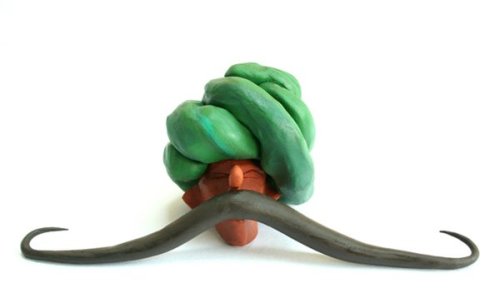
Moochwala
Filed under: Indian Craft | 25 Comments
Tags: Clay faces, Somak, Spastic Plastic, Sunnyside Up
Discovered! Purvi Sanghvi
*An Indian By Design Exclusive*
Purvi recently graduated with an MA in jewellery design from the John Cass Dept (London Metropolitan University). These are just a couple of pieces from a collection she’s putting together. Loved them. Plenty of potential.
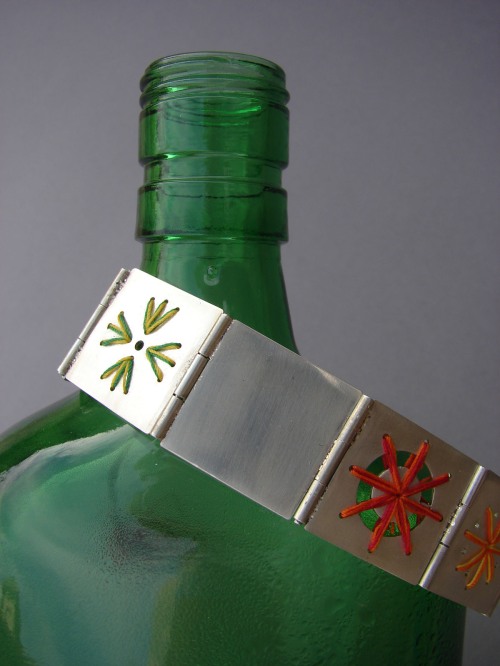
Filed under: Indian Product Design | 22 Comments
Tags: Indian Jewelry Design, Purvi Sanghvi, Recycled Rubber, Silver, Threadwork
*An Indian By Design Exclusive*
Bijoy Jain’s works remind me of a refuge, a sanctuary. Almost as if he was recreating spaces he finds comfort in – an underlying wish for peace. I visited his office and had a conversation over good coffee. About his projects, architecture, even why the interiors of all his projects were so bare; no art on the walls, simple to the point of being austere. I was told they were shot before the owners moved in with their furniture and aesthetics. Clearly, there is great importance he accords to his work, his people and his peace. Presenting a selection of his works and thoughts.
> The Palmyra House, Nandgaon, Maharashtra, India, 2007
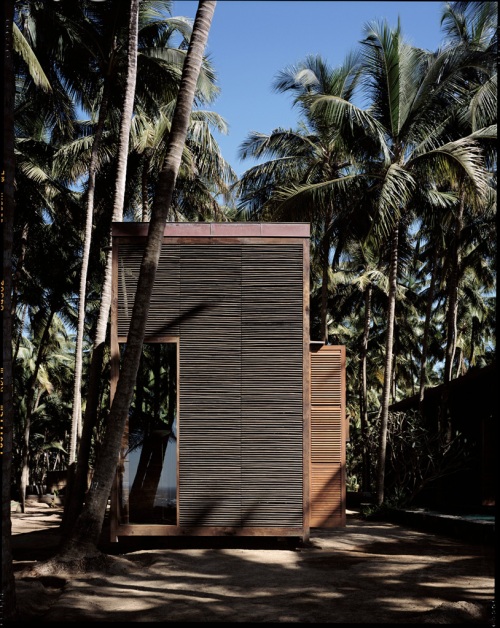
Filed under: Indian Architecture, Indian Interiors, Indian Stores | 34 Comments
Tags: Bijoy Jain, Bungalow 8, Indian Architecture, Leti 360, Palmyra House, Studio Mumbai, Tara House
Window Shopping> Bombay Electric
*An Indian By Design Exclusive*
I stumbled upon Bombay Electric a long time ago, while waiting for a friend to turn up. The light pole outside had a stunning face, like a bohemian 70 s star, with a bindi and high hair and the signage did justice to the name. I walked in, past the leisurely courtyard into the white brightly lit space. The interesting non-interfering decor aside, I was struck by the individuality the clothes had – they were quirky, unique, had a distinct sense of style, and were unlike the usual boutique picks. The merchandise was progressive, spunky and for people who knew themselves. I picked a book on matchboxes and walked out flagging many things I’d like to come back for. Featuring Priya Kishore’s sizzling Bombay Electric.
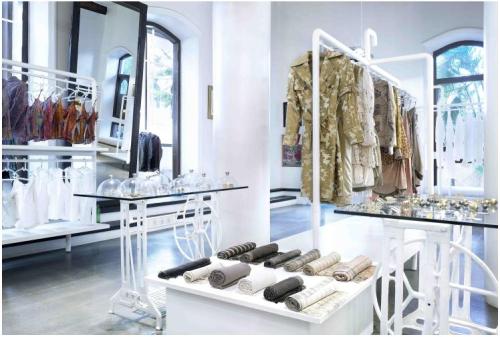
Filed under: Indian Fashion, Indian Stores | 6 Comments
Tags: Bombay Electric, Indian Design, Priya Kishore, Store
I stumbled upon Bhuri Bai’s work on Hervé Perdriolle’s blog and was fascinated by her imagination and craft. Found the interesting works of Jangarh Singh Shyam and Jivya Soma Mashe as well. Presenting all three.
Bhuri Bai, Bhill Tribe
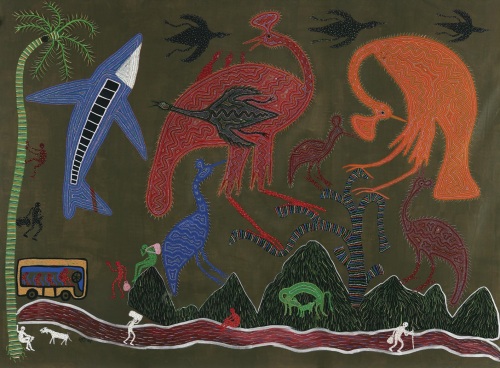
Bhuri Bai, Story of a Jungle, 70 by 93 in. (178 by 236 cm.)
Continue reading ‘Three Tribal Artists > Bhuri Bai, Jangarh Singh Shyam, Jivya Soma Mashe’
Filed under: Indian Art | 18 Comments
Tags: Bhuri Bai, Herve Perdriolle, Indian Tribal Art, Jangarh Singh Shyam, Jivya Singh Mashe
Just Spotted! SK Srikanth
*An Indian By Design Exclusive*
A photographer by interest and instinct rather than by profession, Srikanth has a great eye for subjects and situations. I have three of his prints hanging on my wall at home and am featuring many more here.
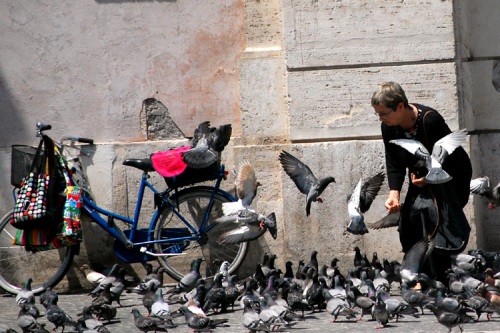
Lady feeding Pigeons
Filed under: Indian Photography | 8 Comments
Tags: 4 by 6, Indian Photography, SK Srikanth, Utopia
Discovered! Mom Made Co.
*An Indian By Design Exclusive*
Mom Made Co is the brainchild of Bhautik Siddhapura who decided to hand make all his t-shirts. Each one is numbered, handpainted and unique. Here are a few of them.
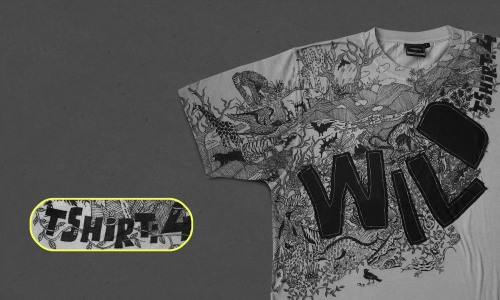
Filed under: Indian Art, Indian Graphic Design, Indian Product Design | 3 Comments
Tags: Bhautik Siddhapura, Mom Made Co, T shirt Design
Just Spotted! Mann Singh
A friend sent me a link to Mann Singh’s work. He works on varied things from lights to furniture to accessories and most of his work has a poetic bent. Featuring a few of his explorations.
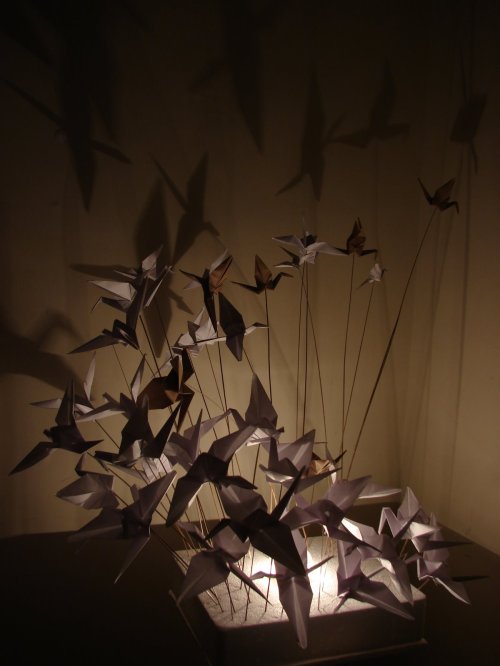
Mann+Siddhartha
Filed under: Indian Interiors, Indian Product Design | 7 Comments
Tags: Bamboo Lamp, Indian Interiors, Indian Product Design, Madhav, Mann Singh, Siddharthatterjee
Quoted > On Luxury
For me luxury means the ability to surround yourself with
an abundance of pure and natural materials.”
– Anita Lal, Creative Head, Good Earth
Filed under: Uncategorized | 1 Comment
Tags: Anita Lal, Good Earth, Indian Interiors, Luxury, Quoted
Archi Feature > Samira Rathod
*An Indian By Design Exclusive*
The first thing that strikes you about Samira is that she’s extremely passionate. I met her at the opening of the Devi Arts Foundation, in the midst of a sandstorm, her hair flying as wildly as her hands, as she shared her thoughts on modern Indian Architecture and design criticism or rather the lack if it. I got back to Mumbai and saw her work. It was as spirited as she was. Her windows were welcoming, her buildings had a body language. I had reservations about her furniture, but the more I look at them, I more I appreciate their individuality and enjoy their original aesthetic. Architect, Interior Designer, Furniture designer, Editor, quirky lady, here is a peek into Samira’s work and her mind.
The Architecture Projects
> The Bangalore House

Filed under: Indian Architecture, Indian Interiors | 2 Comments
Tags: Architect, Indian Architecture, Indian Interiors, Samira Rathod
Aarohi Singh is a self taught artist. She paints in Oil, Acrylics, Watercolor, Pastels and works on Paper, Canvas, Metal, Cardboard, Wood, Fabric. Ambika from Little by Little(lovely girl, much potential) mentioned her. So I checked her website. I like what Aarohi’s done with the trunk and chair and the kettle. Her paintings though didn’t make it to the list or catch my eye, except a series of cows which was interesting.
Filed under: Indian Art, Indian Interiors | 5 Comments
Tags: Aarohi Singh, Ambika Rao, Indian Kitsch, lillbylill
View the entire campaign here.
Filed under: Indian Advertising | 2 Comments
Tags: Advertising, Less Plastic More Life, Meridian Advertising, Plastic, Vinod Lal
Just spotted! Jigisha Patel
Jigisha Patel, a textile designer, trained at NID Ahmedabad. Seen here, her explorations in felt. She works with the natural colour of wool, uses only 100% Merino, and is inspired, among other things, by Indian architecture. A look at a few pieces from her collection.
Filed under: Indian Product Design | 7 Comments
Tags: Felt, Jigisha Patel, Merino Wool, NID, Textile Designer
Samira Rathod’s home is tucked away from the road, in Breach Candy. Trees and birds and silence fills the pathway to her ground floor residence. The long narrow corridor that the front door opens to splits the home halfway. The Living, Dining and Master Bedroom on the left and the children’s room and kitchen on the right. Giant ceilings, large windows, it seems more like a lazy Goan Villa. A balcony runs from the Living to the Dining, ensuring her labrador has many exits and entries to rush in through.
Filed under: Indian Interiors | 9 Comments
Tags: Indian Interiors, Laxminiwas, Residence, Samira Rathod
*An Indian By Design Exclusive*
Tara was my first feature on Indian By Design. I was fascinated by the handmade children’s books they published. My favourite being The Night Life of Trees. The artists from Gond – Bhajju Shyam, Durga Bai and Ram Singh Urvet – were a revelation. A collective of writers based in Chennai, Tara works with international artists and writers as well as tribal artists, oral storytellers, street and billboard painters. Here we are, in conversation, with Gita Wolf, founder of Tara. Also featuring, a video on how Tara makes their handmade books.
Continue reading ‘In Conversation > Gita Wolf, Tara Publications’
Filed under: Indian Art, Indian Graphic Design | 4 Comments
Tags: Gita Wolf, Indian Children's Books, Indian Design, Tara Publishing
Now Showing > Chidiya Udd
Kavita’s having her first solo exhibition. If you’re in Bangalore, do attend. She does great work.
Filed under: Indian Art | 1 Comment
Tags: Chidiya Udd Solo Exhibition, Indian Art
Photo Feature> Zubin Pastakia
*An Indian By Design Exclusive*
I came across Zubin Pastakia’s work in the Spade Journal. His study of Mumbai was refreshing, and refrained from talking of its old charm or it’s rushed populace, but seemed to focus on silent, perhaps unconscious conversations a city’s built strucures have with those who live in it or visit it. His work on Cinema Halls is alive. Like a commentary in the present, of things happening now. It does not attempt to romanticise their existence and leaves the viewers to make stories of it. Featured, The Cinemas Project and Built Landscape.
The Cinemas Project
Filed under: Indian Architecture, Indian Photography | 6 Comments
Tags: An Indian By Design Exclusive, Built Landscape, Cinemas Project, Indian Photography, Mumbai, Zubin Pastakia
Book Talk > Spade
Spade is a biannual journal dedicated to Indian Architecural Design. My first reaction when I opened the large courier Editor Samira Rathod mailed across was to its generous proportions. It was beautifully typeset, had great photography, no ads and ample words which promised heavy reading (and sitting in shifting positions having its large pages curl over my hands).
Filed under: Indian Architecture, Indian Interiors | 4 Comments
Tags: Architecture, Design, Indian, Journal, Samira Rathod, Spade
A design representation for ‘Can anything be beautiful?’. Created for W+K SIDE in London, by Latheesh Lakshman who emphatically believed yes. This is his series – India, everyday life.
Filed under: Indian Advertising, Indian Graphic Design | 15 Comments
Tags: Graphic Design, Indian Design, Latheesh Lakshman, W+K
*An Indian By Design exclusive*
In conversation with Anupam Poddar, Devi Art Foundation
IndianByDesign:Can one clearly distinguish between art and what is not art, today?
Anupam Poddar: I think it is still easy to tell what is ‘art’- the sanctioned and sanctified object. It is not as if we have moved much beyond that system of objects called ‘art’ as much as the system itself has become more inclusive, it’s modes of operation still quite the same… it has become sharper and more cunning though. On a completely personal note, I am often trying to find a continuum between art and architecture.
Filed under: Indian Art | 3 Comments
Tags: An Indian By Design Exclusive, Anupam Poddar, Devi Art Foundation
Design Feature > Anek Taanka
Kavita and Shami gifted me a Salman Khan cushion cover, hand-painted by a hoarding artist. It was quirky and very kitsch, and my introduction to Varsha Sharma’s work. But after seeing more of what she does, I am partial to her weaves and threads and fabrics. A graduate in Textile Design from NID, she started Anek Taanka a couple of years ago. Anek Taanka means infinite stitches. And her work is filled with it. She says “my challenge is to create pieces of textile that could inspire spaces to be designed around them rather than the other way around.” It is a big promise to make and I do hope that she does so, it would be wonderful to experience such a thing. Here are some of my picks of her work.
Cushion Covers
Filed under: Indian Interiors | 14 Comments
Tags: Anek Taanka, Indian Design, Varsha Sharma
Art Feature> Devi Art Foundation
*An Indian By Design Exclusive*
The opening of Lekha and Anupam Poddar’s new not-for-profit art space would preempt a surfeit of words on artists and collections. But I choose to speak first of their latest commissioned work – the Sirpur Mills Building. For it is as much art as all that it holds or will hold within it.
Filed under: Indian Architecture, Indian Art | 4 Comments
Tags: Anupam Poddar, Art feature, Devi Arts Foundation, Gurgaon, Indian Architecture, Indian Art, Lekha Poddar, Sirpur Mills Building
Just Found! Infomen Art
Infomen is an Information and graphic design firm jointly run by designers Aman Khanna and Carlos Coelho. It operates from their studios in New Delhi and London. Here’s a series of eye-catching posters and bags designed by them, that’s on sale, on their site.
Cosmos – A series of posters inspired from electronic music and symbols
Filed under: Indian Graphic Design | Closed
Tags: Aman Khanna, Bags, Carlos Coelho, Design, Graphic Design, Indian, Infomen, Posters
Culinary celebrity Marut Sikka’s daytime café turned evening sit-down, Magique, in the Garden of five senses is set in a Delhi public park. This Asian fusion restaurant designed by Lotus Design has created quite a buzz since it opened last year. Indian by Design serves up assorted pictures garished with a quirky identity. (p.s: I have been warned that the pictures don’t do justice to the magical ambience of the place. Leave a comment if you’ve actually been there)
Filed under: Indian Graphic Design, Indian Interiors | 3 Comments
Tags: Ambrish Arora, Ankur Choksi, Arun Kullu, Asian Fusion, Brand Identity, Garden of five senses, Indian Graphic Design, Indian Restaurants, Infomen, Lotus Design, Magique, Marut Sikka, Sidhartha Talwar
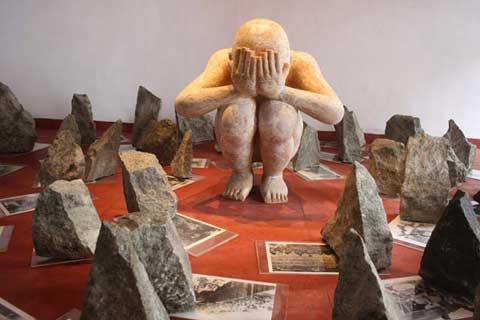
Speaking Stones, 1998 by NN Rimzon . Now showing at Kashi Art Gallery as part of the ONLY ONE series.
Continue reading ‘Caught my eye > NN Rimzon, Brighu Sharma, Ratheesh T, Rajan Krishnan’
Filed under: Indian Art | 3 Comments
Tags: Brighu Sharma, Indian Art, NN Rimzon, OED, Ore, Rajan Krishnan, Ratheesh T

Occupying Silence by Devashish Makhija. At Gallery Kanishkas, Calcutta. From 21 August to 10 September 2008. Write to nakedindianfakir (at) gmail (dot) com to buy/preview the catalog. I enjoyed the beautifully written notes from the past that inspired his works.
Filed under: Indian Art | 3 Comments
Tags: Devashish Makhija, Gallery Kanishkas, Graphic Verse, Indian Art
ArchiFeature > Aniket Bhagwat
*An Indian By Design Exclusive*
I featured Aniket Bhagwat last month, and there has been considerable interest in his work; landscape and architecture. So I got in touch with him (thanks to dear friend Ambrish), and dug deeper into his works and thoughts. Here’s Aniket Bhagwat, talking about his projects, meandering into thoughts on architecture, Spade – an Indian architectural design magazine published with peers, and finally wrapping up in a discussion on enduring design.
> Sirpur Paper Mills
Filed under: Indian Architecture | 24 Comments
Tags: An Indian By Design Exclusive, Aniket Bhagwat, Indian Architecture, Indian Design, Indian Landscape Design
Just Found! Pardon My Hindi
Pardon My Hindi was started by Chiraag Bhakta back in 2002. Currently all the products in the PMH store are designed by him as well. He adds, ‘PMH is always looking for people to contribute an idea, whether a product, a graphic or a contribution to the e-zine (What’s the Samachar, that comes out 4 times a year). PMH is based in Brooklyn but has an online store where you can see everything on offer.
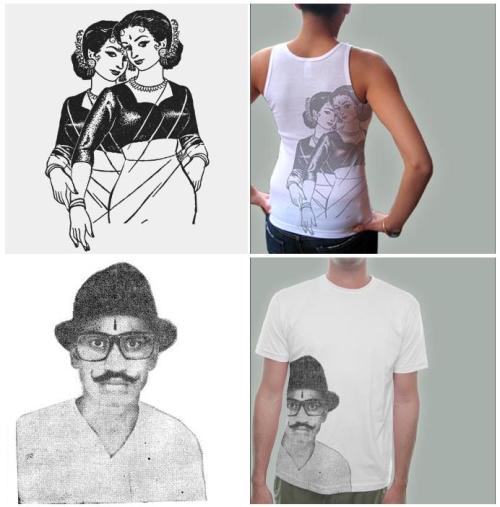
Filed under: Indian Graphic Design, Indian Stores | 4 Comments
Tags: Bags, Chirag Bhakta, Indian Graphic Design, Just Found, T-shirt, What's the Samachar
*An Indian By Design Exclusive*
I remember the first time I walked past the giant metal doorway, smooth pebbles curving into my flats, and experiencing Cinnamon. There was an air of quiet elegance about it. Along with a light-filled positivity that made you want to linger. Quirky artifacts, accessories and clothes were artistically placed around the 2000 sqft space, each handpicked for character and design. I remember picking quaint wooden bees on sticks, newspaper roll containers, Jason Cherian skirts, Michael Aram silver, glass fish. Today, I feature it with much nostalgia and hope that it remains as relevant to tomorrow as it was for yesterday. Here’s Radhika Poddar, owner and aesthetic guardian of this lovely place, in an informal chat about her love and longing for Cinnamon.
Continue reading ‘In Conversation > Radhika Poddar/Cinnamon’
Filed under: Indian Interiors, Indian Stores | 3 Comments
Tags: An Indian By Design Exclusive, Cinnamon, Design, In Conversation, Indian Retail, Indian Stores, Interiors, Radhika Poddar
I support > Craft Revival Trust
The Craft Revival Trust covers an exhaustive spectrum of information on handicraft, handloom, folk and tribal art in Asia. The content is sourced from a wide, credible and knowledgeable network of researchers, practitioners, academics, students from across the world. Now available for sale at the Craft Online Shop
Peacock Pencil, Parrot Pencil, Windmill Pencil
Filed under: Indian Art, Indian Graphic Design, Indian Product Design, Indian Stores | 1 Comment
Tags: Craft Revival, Design, I Support, Indian, Indian Craft
Paul has been a journalist, socio-cartoonist, set designer and electrical engineer prior to being a practicing product designer. He is married and lives with his wife, a toy designer, in Noida.
 ATE is a double bladed stainless steel pencil sharpener which sharpens large and small pencils to a comfortable sharp tip. Best feature > single cut twin blade / rubberized end rims for softer edges / satin finish Awards > red dot award : design concept 2007 / Jindal Stainless Innovation Award’
ATE is a double bladed stainless steel pencil sharpener which sharpens large and small pencils to a comfortable sharp tip. Best feature > single cut twin blade / rubberized end rims for softer edges / satin finish Awards > red dot award : design concept 2007 / Jindal Stainless Innovation Award’
Continue reading ‘Just Found! Paul Sandip’s everyday objects’
Filed under: Indian Product Design | 10 Comments
Tags: Indian Design, Indian Product Design, Just Found, Paul Sandip
Now Showing > Dhruvi Acharya
 “ONE LIFE ON EARTH” will be on view from August 7 – 30, 2008 at Chemould Prescott Road in Mumbai and from October 4 – November 1, 2008 at Nature Morte in New Delhi. More work on her website.
“ONE LIFE ON EARTH” will be on view from August 7 – 30, 2008 at Chemould Prescott Road in Mumbai and from October 4 – November 1, 2008 at Nature Morte in New Delhi. More work on her website.
Filed under: Indian Art | 2 Comments
Tags: Design, Dhruvi Acharya, Exhibit, Indian, Indian Art, Now Showing
Conceptualised in 2007, Memories of a Butterfly specializes in Bead Curtains and Murals. They say ‘Bead Curtains not only allow for a play with color, light and texture, but also enable us to create natural connectors between spaces. They have the ability to create privacy without disconnecting an area from the rest of the house, office, bar or restaurant’. I like their experiments with patterns, especially the Ikkat and graphics. Apart from curtains, MOAB also has box lamps, hanging lamps and candle stands with intricate bead work.
Filed under: Indian Interiors | 17 Comments
Tags: An Indian By Design Exclusive, Beads, Discovered, Indian Interiors
I support > www.treesforfree.org
I planted two fruit trees with them, and it was a wonderful experience. Here’s what they do, from the horses’ mouth:
We plant trees for free to heal the earth. As of now, we do this in Bangalore only. So if you know any place where a tree can take root and flourish, let us know. We’ll do the rest. You’re welcome to join us as a volunteer or a “tree planting member” (one who gives 100 rupees to plant a tree, every month). We also plant trees as a living tribute to your birthday, anniversary, or any other day that you want us to. If you like what we do, then feel free to spread the good word about our work. Speak to your friends, family, your company’s CSR department..do whatever it takes to spread some greenery and heal the earth.
Filed under: Indian Advertising | 5 Comments
Tags: Guerrilla Advertising, I Support, Indian Advertising, Save Trees
Good Earth just opened the doors to its enigmatic flasgship store in Saket, New Delhi. The products lend it the same air of familiarity, but the subtle yet mammoth design differences take you into a new space altogether. Designed by the immensely talented Lotus Design (Mehrangarh museum shop, Levi’s Rivet, Xylys, Khaja Chowk…), it’s dazzling, and definitely worth stopping by.

Continue reading ‘Design Feature > Good Earth Flagship Store, Delhi’
Filed under: Indian Interiors, Indian Stores | 15 Comments
Tags: Ambrish Arora, Ankur Choksi, Arun Kullu, Design Feature, Indian Interiors, Indian Stores, Lotus Design, Sidhartha Talwar
Just Found! Anagram’s Facade
Filed under: Indian Architecture | 3 Comments
Tags: Anagram, Indian Architecture, Just Found
Filed under: Indian Art | 3 Comments
Tags: Art Walk, Bharti Kher, Indian Art, Installation
*An Indian By Design Exclusive*
I first saw her poring over sketches and doodles and drawings and a half-finished series of Cats on Chairs. She was so childlike in her enthusiasm, in her curiosity for feedback. Her art, much like her, is simple, genuine and rooted. In conversation with Kavita Arvind, artist, NID faculty and founder of Chidiya Udd. She creates art ranging from childrens’ literature, gender and social communication to commissioned works for individuals, NGO’s and other organizations.
Continue reading ‘In Conversation> Kavita Arvind/Chidiya Udd’
Filed under: Indian Art | 5 Comments
Tags: An Indian By Design Exclusive, Chidiya Udd, In Conversation, Indian Art, Indian Design, Interview, Kavita Arvind
Window Shopping > Atmosphere
Atmosphere, owned by Himatsingka Seide, is probably India’s first luxury home furnishing fabrics store chain.With over 2000 styles of fabrics in every store, the striking ensemble is well suited for home and commercial decor.

Continue reading ‘Window Shopping > Atmosphere’
Filed under: Indian Interiors, Indian Stores | 1 Comment
Tags: Atmosphere, Fabric, Indian Stores, Interiors, Window Shopping
On the list of the coolest companies in India (Business Today, Sep 2005), Happily Unmarried started as a one stop shop for people living on their own, providing services like accommodation, furniture on hire, rugs, curtains, kitchen essentials, but later shut everything else down and focussed on creating quirky Indian products. The creators have a whacky sense of humour and their packaging makes for a good read.
The Indian Handpump Bottle Stopper 
Continue reading ‘Design Feature > Happily Unmarried’
Filed under: Indian Product Design | 1 Comment
Tags: Design Feature, Happily Unmarried, Product Design
Discovered! – Pet Bottle Art
Filed under: Indian Graphic Design | 3 Comments
Tags: An Indian By Design Exclusive, Art, Discovered, Indian Graphic Design
 I love her style, and I think she’s priced it very reasonably – Rs 7000 to Rs 22000. Contact Kavita Arvind. A-406, Fourth Floor, Purva Sunshine, Main Sarjapur Road, Bangalore 560008. Email: chidiyaudd at gmail.com. Website: http://www.chidiyaudd.in. Work can be couriered to other cities.
I love her style, and I think she’s priced it very reasonably – Rs 7000 to Rs 22000. Contact Kavita Arvind. A-406, Fourth Floor, Purva Sunshine, Main Sarjapur Road, Bangalore 560008. Email: chidiyaudd at gmail.com. Website: http://www.chidiyaudd.in. Work can be couriered to other cities.
Filed under: Indian Art | 2 Comments
Tags: Indian Art, Kavita Arvind, Shout Out
Europe belongs to Picasso, Matisse and Braque and many others. India belongs only to me.
She died at an age people start discovering what they’re all about. 28. Too young. 1913-1941. But what a life it’s been.
Continue reading ‘Art Walk > The resurrection of Amrita Sher-Gil.’
Filed under: Indian Art | 1 Comment
Tags: amrita sher-gil, Art Walk, Indian Art, Tate Modern
*An Indian By Design Exclusive*
Rajiv Majumdar’s 450 sq ft apartment had just enough space for his 6 foot 4 frame, his guitars, books and speakers. Though it did have its plus points. Enough light from a long balcony and enough freedom to break down all the walls as the flat belonged to his mother.
The first thing he did was break a few walls – the kitchen, the balcony, the bathroom and the bedroom. Then set up a fully equipped kitchenette with a sliding mirror door that shut when not in use, which is almost always (I did suggest he dismantle it and set up a phone, for takeaway).
The Living (he designed everything including that big comfortable bench and the delightful rug, except for, of course, the ‘insert drumroll here’ Eames Chair)

Continue reading ‘CHAI @ RAJIV MAJUMDAR’S 450 Sqft HOME’
Filed under: Indian Architecture, Indian Interiors | 48 Comments
Tags: 450 sqft, An Indian By Design Exclusive, Architect, Chai, Home, Indian Architecture, Interiors, Rajiv Majumdar
ArchiTalk: Landscape India
Supported by a vast database of landscape techniques and plant material, Aniket Bhagwat’s firm handles residential, industrial, recreation, urban, institutional landscapes, and ecological redevelopment projects.
Andaman; Currently designing a twenty two-room boutique hotel on the sea, on a land measuring 10.5 acres, which is covered with Areca nut trees and coconuts. The site is undulating, and has a stream that runs through it. Work involved: Site planning, Architecture, Interior Design and Landscape Design.
Continue reading ‘ArchiTalk: Landscape India’
Filed under: Indian Architecture | 5 Comments
Tags: Aniket Bhagwat, ArchiPick, Indian Architecture, Landscape
Window Shopping > Loose Ends
Loose Ends, located in Bandra, Mumbai, is a quirky garage store that retails home accessories and clothes and oddities.
Filed under: Indian Stores | 3 Comments
Tags: Indian Interiors, Indian Product Design, Loose Ends, Shop, Window Shopping

Tara is run by a collective of writers based in Chennai, India. They work with a range of adventurous writers and artists from around the world, and create books in house as well. I loved their Indian sensibility and their aesthetics. Beautiful.


You’ll find them here.
Filed under: Indian Art, Indian Graphic Design | 1 Comment
Tags: Children's Books, Indian Art, Just Found, Publishing, Tara
